Teachers Matter
The Magazine of Spectrum Education

Who’s Your Mentor?
Helping Children Handle Bullying Creating a Culture that Actively Promotes Wellbeing
Embracing Silence
PROFESSIONALLY & PERSONALLY
Leaders in Developing Teachers ISSUE 62

2

Dear Readers,
It is with a heavy heart that we relay the loss of one of our most beloved contributors, Alan Cooper, passed away in February. He lived a long, full 88 years. We here at Teachers Matter Magazine are so grateful for all the years that we were blessed enough to read his words of wisdom on our pages. What an impact he made on our magazine and our readers’ lives.
When thinking about our lives, as many do, we often think of the impact we may or may not be having on those around us. Teachers tend to do this type of reflective questioning at multiple points in a single school year. Caleb Wesco tackles this topic head on in his article entitled, “You’re Making a Difference.” The inspiration of this true story will leave an impression on your heart, I’m sure, as it did my own.
Oftentimes, making sure we are having that ripple-effect of impacting others, we need some guidance when self-doubt tries to creep in. You know, those days when your desk is piled high with papers to grade, plans to write, and emails to answer? (I’m looking at my desk literally right now and seeing these exact things!) When those moments get to us, we sometimes need to seek out the company of a mentor teacher…or to be the mentor to someone else. Sally Foley-Lewis explores the topic of those relationships in her article, “Who’s Your Mentor?”
Lastly, don’t miss our own Karen Tui Boyes’ article, “Embracing Silence.” Every time of year, there is always a busy push at some point within it where life seems to be so chaotic that it’s difficult to think straight and keep track of all that should be done. After taking her own silent journey, Karen shares some profound (but easy and attainable!) ideas for finding a way to quiet our busy minds. As a mom here in America whose second-born is getting ready to walk across the graduation stage later this month, I needed this one!
Yours in Education,


Like TeachersMatter on Facebook
3 EDITOR’S NOTE



In This Issue p10 – The Power of Readers Theatre p22 – Put the Pen to the Paper p30 – Helping Children Handle Bullying 6 How to Ignite and Develop Leaders HELEN VERROUX 8 Who’s Your Mentor? SALLY FOLEY-LEWIS 10 The Power of Readers Theatre KAREN TUI BOYES 12 Reflections of a Teacher about Generative Artificial Intelligence DR. SUSAN NEIMAND & ERIKA TWANI 15 Quote 16 The 3 E’s – Education, Experience and Execution BILL SOMMERS 18 Moving Students with Anxiety Forward VANESSA MCHARDY 21 Quote 22 Put the Pen to the Paper JESSYKA COULTER 24 Harnessing the Power of Artificial Intelligence BARRY COOPER 26 Cultivating a Growth Mindset SALLY FOLEY-LEWIS 28 You’re Making a Difference CALEB WESCO 30 Helping Children Handle Bullying KARI SUTTON 32 From Plumbing Pipes to Pedagogy
34 Not Enough Time for Student Leadership? MICHAEL
4 Teachers Matter CONTENTS
LILI-ANN KRIEGLER
GROSE
To
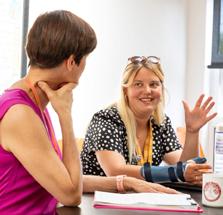

Teachers Matter Magazine Team
Publisher, Sales and Advertising
Karen Tui Boyes
karen@spectrumeducation.com
Editor
Jessica Youmans
Art Director
Andrea Aragon-Echano
Magazine Co-ordinator
Mindy Sutch
hello@spectrumeducation.com
Email: info@spectrumeducation.com
Thanks to the educators, speakers and authors who contributed interviews, articles, photographs and letters.
Teachers Matter magazine is registered with the National Library: ISSN 1178-6825
© Spectrum Education 2023
All rights reserved.
Parts of this publication may be reproduced for use within a school environment. To reproduce any part within another publication (or in any other format) permission from the publisher must be obtained.
The opinions expressed in Teachers Matter are those of the contributors and we love them!
Spectrum Education Ltd
Address: 19 Rondane Place,
Hutt, New
magazine@spectrumeducation.com
Subscribe today
receive your own digital copy of the next issue, send an e-mail to magazine@spectrumeducation.com
Subscriptions
All Enquiries
Lower
Zealand
www.spectrumeducation.com p42 – Creating a Culture that Actively Promotes Wellbeing p52 – Dancing Hands – Hand Talk 37 Quote 38 Master the Art of Essay Writing KAREN TUI BOYES 42 Creating a Culture that Actively Promotes Wellbeing THERESE HOYLE 44 Keeping Kids Safe GLORIA MASTERS 46 A Guide for Teachers: Techniques for Dysregulated Students SUE O’CALLAGHAN 48 Understanding and Feeling Excited About Compounding LAUREL MAKOWEM 50 What Chicken Nuggets Taught Me JUDITH YEABSLEY 52 Dancing Hands – Hand Talk LESLEY JOHNSON 55 Embracing Silence KAREN TUI BOYES 5 MAGAZINE CONTACTS
HELEN VERROUX
How to Ignite and Develop Leaders
Creating Meaningful Connections in Your School

In a world where everything is constantly evolving, the school system is still the same - teachers are still working diligently to meet the needs of students. They feel the weight and pressure of making a difference in the Gen Z generation - a sometimes unmotivated, disengaged generation who often finds it easier to live and communicate in a virtual world rather than a real one. No matter how difficult the newest generation may appear, teachers never give up.
Despite the critics, the work overload, new government policies, the lack of financial and emotional support, the parents’ and students’ disengagement and the decrease of mental health awareness in school, how can we still ignite passion, develop leaders and create meaningful connections in your school community? The following is a valuable framework that will shift your mindset on how you can make a difference now in your school community.
1.Define Your Mission
As an educator, you must be able to have a personal mission statement - a statement that describes your beliefs, your values, who you represent and what you stand for. Many
You are in a culture where people have a sense of belonging and this is when meaningful connections can be nurtured.
people are part of a community or part of a school whose mission does not align with theirs. In order to make a difference in your school community and ignite people around you, you must first clarify your uniqueness, your passions to be able to add value where you are planted. Sometimes it takes one person like you to bring a spark in someone’s life just because you want to make a difference
Teachers Matter
6
around you. You have an attitude of service and want to serve the people around you with your gifts. Things won’t change until you become a change agent, so be the change you want to see and add value to your school.
2. Define Your Message
Many people are scared to stand out because they worry too much about other people’s opinions, they lack selfconfidence or they do not see themselves as change agents. They often prefer to fit in rather than to stand out. It is important to fight for a cause and that the people around you understand your message and dedication.
People are attracted to leaders. In a world where leaders manipulate the masses for their own gain, people are looking for leaders they can trust and they can submit to. When you get clarity on your specific message, you can connect heart-to-heart with your community. When focused on others’ well being, inner healing and personal growth, people can positively change a community. To do so, leaders must ignite others from within by using heartfelt emotions such as love and compassion.
3. Be Part of a Movement-Based Community
When you are part of a movement-based community, you are part of a culture where everybody speaks the same language, while sharing the same beliefs and values as you. People are transformed from within and become transformational leaders rather than transactional leaders.
You are also part of a purpose-led community where you can see those who fit within the culture, and those who do not fit within the culture. Even if they do not fit at the beginning, based on your mission and message, they will want to submit easily to leadership. You are in a culture where people have a sense of belonging and this is when meaningful connections can be nurtured. Being part of a community where your ideas are shared, you are heard and valued makes you feel understood. It all starts with you as a leader.
It is only after you have implemented the three “M’s” that you can develop leaders around you. Which “M” would you focus on first?

Teen Leadership Coach Expert. Author. Entrepreneur. Education Consultant. Founder of The R.P.T.L Academy & The Success Guide For Teens Academy
She helps parents with preteens gain tools to empower them from self-discovery to self-leadership
She can be contacted at thekeysforsuccesscoach@gmail.com
 Helen Verroux
Helen Verroux
7
HELEN VERROUX
Who’s Your Mentor?
Everyone Needs a Guide - Even You!

In her memoir, Becoming, Michelle Obama shares how she was appointed as Barack Obama’s mentor at the law firm they worked at, even before they were married. We often hear Barack crediting Michelle as being the success and support behind his achievements.
Some other famous mentoring match ups include…
• Oprah Winfrey and Barbara Walters
Oprah Winfrey once said of Walters, “Had there not been you, there never would have been me.”
• Bill Gates and Warren Buffet
Gates has referred to his long time mentor, Warren Buffet, as, “one of a kind.”
• Plato and Socrates
As far back as 400 BC, Socrates mentored Plato. Plato went on to mentor Aristotle, which goes to show that the student can become the master; or the mentee can also be the mentor.
A common understanding of what mentoring is involves someone wiser, more experienced and older supporting, advising, teaching and/or guiding someone younger, less experienced and less advanced in their career.
While this is an example of a mentoring relationship, mentoring can do so much more for firing up confidence, influence and courage through visibility.
Being more visible is about being seen as an expert with integrity; being the first person others think of when they
A mentor will serve as your guiding light, offering personalised advice and resources to enhance your teaching techniques, expand your subject knowledge and explore innovative pedagogical approaches.
Teachers Matter
8 SALLY FOLEY-LEWIS
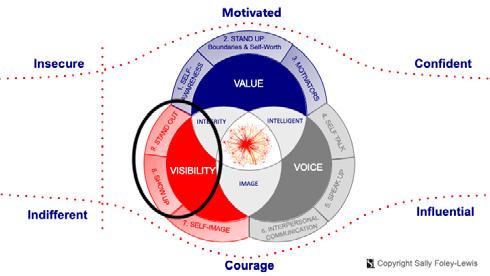
need to call on the skills and knowledge you have.
Being more visible, being front of the mind of the key decision makers, puts you at the head of the line for opportunities.
As a teacher, who do you look up to in your organisation or industry?
Mentors can do much more than provide advice and guidance through their own experiences. Mentors can be:
• ROLE MODELS: They have the skills or leadership you can observe and learn from to influence your own journey.
• SPONSORS/BROKERS: They have the connections and can call in favours or recommend or refer you for opportunities.
• ADVOCATES: They can be your cheerleader, encouraging you to show up through, for example, accompanying the mentor to meetings and events in which you may not normally have access.
Mentors can be internal or external to your organisation or industry.
Mentors can be engaged for a short term period or a long term.
Mentors can be younger than you, not just older than you.
Mentoring can be formal or informal.
Mentoring can also be virtual: as in you observe them from afar, they may never know they’ve been a mentor to you. Nelson Mandela is said to have been influenced by the books and writings of Mahatma Gandhi.
Teaching comes with its unique set of challenges, from classroom management to curriculum development. Having a mentor provides valuable insights and strategies for you to navigate through these obstacles, drawing from their wealth of experience. It’s not a secret that continuous growth is essential for educators. Having a mentor will serve as your guiding light, offering personalised advice and resources to enhance your teaching techniques, expand your subject knowledge and explore innovative pedagogical approaches.
When you think about being more visible, who would be your dream mentor - and who could your mentor?
 Sally Foley-Lewis
Sally Foley-Lewis
Sally helps middle managers be productive leaders. She is a global, multi-award winning Certified Speaking Professional, who’s helped over 20,000 middle managers from diverse industries, locally and globally. With her unique blend of experiences, exceptional qualifications and humour, Sally’s keynote presentations, workshops and resources inspire, transform and deliver results.
She can be contacted at sally@sallyfoleylewis.com
9 SALLY
FOLEY-LEWIS
The Power of Readers Theatre
A Fun Approach to Boosting Literacy Skills
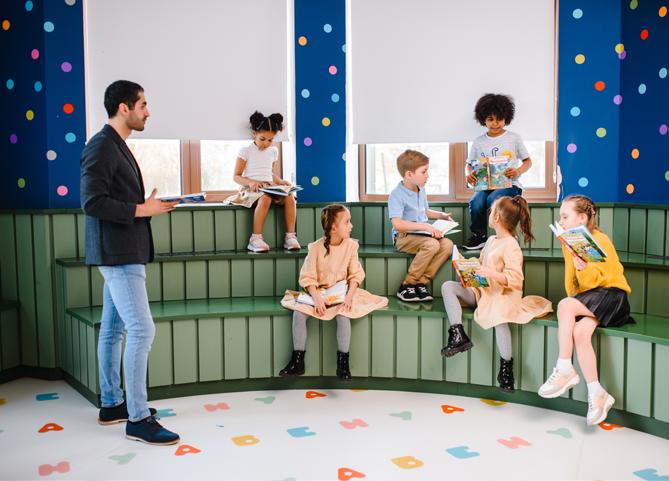
Are you searching for an innovative method to elevate your students’ reading proficiency while nurturing their confidence and imagination? Look no further than Readers Theatre! While it may have been flying under your radar, this dynamic approach to literacy instruction has proven to be a game changer for many educators, including myself. Let’s explore how Readers Theatre can revolutionise your classroom.
Understanding Readers Theatre
Readers Theatre is a collaborative strategy that engages students in reading scripts without the need for memorisation. Through repeated readings, students develop fluency and expression while delving deeper into the characters and plot dynamics of the text.
Why Choose Readers Theatre?
The advantages of incorporating Readers Theatre into your curriculum include:
• Enhances Fluency: Reading aloud fosters accuracy, speed and expression.
• Deepens Comprehension: Performing scripts enriches students’ understanding of the text.
• Promotes Collaboration: Students collaborate, fostering teamwork and communication skills.
• Increases Engagement: The interactive nature captivates students, making reading enjoyable.
• Builds Confidence: Public speaking skills are honed through performance opportunities.
Teachers Matter
10
KAREN TUI BOYES

Implementing Readers Theatre
The process is straightforward and flexible:
1. Select Compelling Scripts: Choose dialogue-rich scripts from various genres to keep students engaged.
2. Choral Reading: Have students read scripts in unison, either as a whole class or in smaller groups.
3. Assign Roles: Allow students to explore different character roles within their groups.
4. Rehearse: Provide time for students to practice their lines, focusing on tone and pacing.
5. Performance: Bring the script to life through a Readers Theatre production, fostering a sense of achievement and pride.
Tips for Successful Implementation
Maximise the impact of Readers Theatre in your classroom with these tips:
• Opt for Engaging Scripts: Select lively scripts with ample dialogue to captivate students.
• Start Slowly: Allow students time to acclimate to their roles and the performance setting.
• Keep it Simple: Performances can take place anywhere, from a classroom setting to an outdoor space.
• Provide Support: Offer guidance on character portrayal, vocabulary and text comprehension.
• Encourage Rehearsal: Practice is key to ensuring a polished performance.
Selecting Texts for Readers Theatre
When choosing material, focus on:
• Compelling Content: Select literature with intriguing stories, characters and dialogue.
• Appropriate Length: Choose texts that flow well and are suitable for oral performance.
• Adaptability: Modify texts to suit students’ reading levels and performance abilities.
Readers Theatre goes beyond just reading; it's about engagement, fluency and confidence.
In Conclusion
Readers Theatre goes beyond just reading; it’s about engagement, fluency and confidence. Integrating this approach into your literacy instruction will create enriched learning where every student can shine in their reading. Give it a go. Dive into the world of Readers Theatre and watch your students’ literacy skills soar!

Karen Tui Boyes
Karen Tui Boyes is a champion for LifeLong Learning and is on a mission to transform education globally. Described as an educational alchemist, a conscious creator and a playful priestess, she grounds the research into practical strategies which positively impact teaching and learning.
A multi-award-winning speaker, educator and businesswoman, she is the CEO of Spectrum Education, Principal of Spectrum Online Academy and the author of 12 books.
Find out more at: www.spectrumeducation.com
11
KAREN TUI BOYES
Reflections of a Teacher about Generative Artificial Intelligence
Will AI Replace Teachers?
Iam a 50-year veteran of the education profession: Teacher, principal, preservice-teacher professor, curriculum developer and Dean of the School of Education at the prestigious Miami-Dade College. I was trained on mimeograph machines, library research and typewriters. As I retired, I saw many of my students challenged by the newest technological advancement: Generative Artificial Intelligence (AI). Simply put, AI is an app. You can “talk” to it by asking it to acquire information for you and receive an answer in text, image, audio or video.
Technology came into my wheelhouse after many years of teaching and in the middle of my career. I have always been open to innovation and new developments, incorporated technology willingly, and never feared being replaced. However, AI has presented new challenges for teachers such as me: Will teachers be replaced? How will the role of a teacher change? How will AI change teachers’ relationships with students? Should students be allowed to use the latest AI? If so, will they know how to use AI properly, or will it become a tool for fraud and cheating? What do teachers
need to know about AI to support students’ learning and proper use of AI? Will AI widen the already wide achievement gap based on socioeconomics? How can we assess students’ progress when using AI?
I had to see it for myself.
I consider myself technologically challenged, and many teachers may relate. So, I prevailed upon my colleague Erika Twani, a software engineer and education AI expert, for some firsthand experience. After working with her in an AI environment, I learned that AI is a tool to support teachers, not supplant them. This is what I learned.
ChatGPT retrieves what teachers learned in college as preservice teachers. ChatGPT does not know more than the collective teacher world, although it may know more than individual teachers or those who come to the teaching profession without adequate training. This was a marvelous revelation to me. I became more secure in my knowledge, training and experience in education.

12
DR. SUSAN NEIMAND & ERIKA TWANI
We explored various “bots” AI trained for a specific purpose. We engaged in different activities with it in order to assess its capabilities. The bots were set up and trained by teachers.
We first explored an outline for a history unit for ninth graders. It was developed in the Relational Learning Framework’s six steps: plan, explore, research, practice, relate and self-assess. The bot was trained to use the Relational Learning Framework and generated the unit based on the framework that was taught. Having developed a unit in Relational Learning in the past, I might have developed a similar unit had I needed it. But because the bot was trained to do it, it saved me unit development time. This is the type of unit that teachers could access and either use for autonomous learning or, in cases where there are no computers for student use or limited Internet access, present the unit to their classes and then assess students’ learning. The unit was comprehensive and thorough.
Next, we asked ChatGPT to develop a new science unit on the start of the universe for fifth-grade students. A complete unit of study was quickly presented to us. I mean quickly, like within less than a minute. While a teacher could design this, and their role in delivering the unit would not change, it would take hours. Lots of time saved.

Different from other times in history, today we have the technology to support teachers’ hard work and to have the results they so much yearn for: their students’ success.
In our next activity, we asked ChatGPT to provide five activities in reading comprehension for fifth-grade students. ChatGPT then provided a rationale as to the importance of these activities. While teachers know this, it was inspiring to read such a statement. The bot provided five engaging activities: Book club discussions, reading comprehension worksheets, interactive story maps, Reader’s Theater and vocabulary-building games. Each activity came with an explanation of how to use it. As an experienced educator, I was familiar with all of these. However, to receive the list in mere seconds was astonishing. Teachers could choose which activities might be best for the students based on their knowledge of students and their learning needs and which would not serve them well.
We further refined the prompt, which demanded little computer knowledge and expertise. For example, we wanted to explore strategies to use Readers Theater. We asked the bot to provide AI apps best suited to teach Readers Theater. The bot complied and gave additional information. The bot could not always provide specific information as our prompts became more discrete. In this case, the bot directed us to various sites to obtain that information with the URLs included. Seconds, mere seconds, to do this. ChatGPT cut planning time, thus allowing teachers to determine the suitability of learning content to students’ proficiency and needs.
Another activity was to ask ChatGPT to teach me how to simplify and graph an algebraic equation. Immediately, steps for the process appeared on the screen. This gave me pause. Mathematics is a challenging curriculum area, and many students, especially girls, fear it. However, the information provided by ChatGPT would serve teachers in multiple ways.
13
DR. SUSAN NEIMAND & ERIKA TWANI
DR. SUSAN NEIMAND & ERIKA TWANI

For classrooms without computer access, teachers could review the steps at home and check their own procedures, seeking more straightforward ways to teach the topic and trying to pre-teach areas of difficulty. For classrooms with computers, teachers could assign this work as autonomous learning to advanced students based on their learning characteristics. Of course, some students would not master the concept in a computer environment, and teachers could have the opportunity to facilitate interventions and 1:1 work.
As we worked through these bots, I realized that AI did not know more than me as a teacher. However, it would:
• Assist by reducing planning time, therefore providing more opportunities to consider students’ proficiency and needs;
• Provide a host of ideas for interventions for better learning and expose new, different, and unknown formats and instructional tools;
• Enhance teaching with information on new tools;
• Enable the differentiation of instruction and promote informed student-teacher interaction; and
• Serve as a mirror to apprise teachers of lesson delivery quality and how to improve this by reviewing new processes and methodologies.
That work session shared the advantages of AI for teachers. It will never supplant or replace teachers, but it will instead make them more efficient and able to meet learners’ educational needs.
We often hear how burned-out teachers are, how much pressure they are under to perform and how much their
students must catch up after the pandemic. Different from other times in history, today we have the technology to support teachers’ hard work and to have the results they so much yearn for: their students’ success.
What we shared in this article is only ONE way to use AI. Teachers can use AI and improve their efficiency tenfold.
Keep learning.
 Erika Twani
Erika Twani
Erika Twani, author, is co-founder and CEO of Learning One to One, where she explores ways to foster human achievement through Relational Learning. Twani has served as Microsoft’s education industry director for Multi-Country Americas. Twani has advised government officials and education leaders on the use of technology, has written various articles on the topic, is a TEDx speaker and has worked with schools to guide the practical use of Relational Learning.
For more, visit www.erikatwani.com
Teachers Matter
14
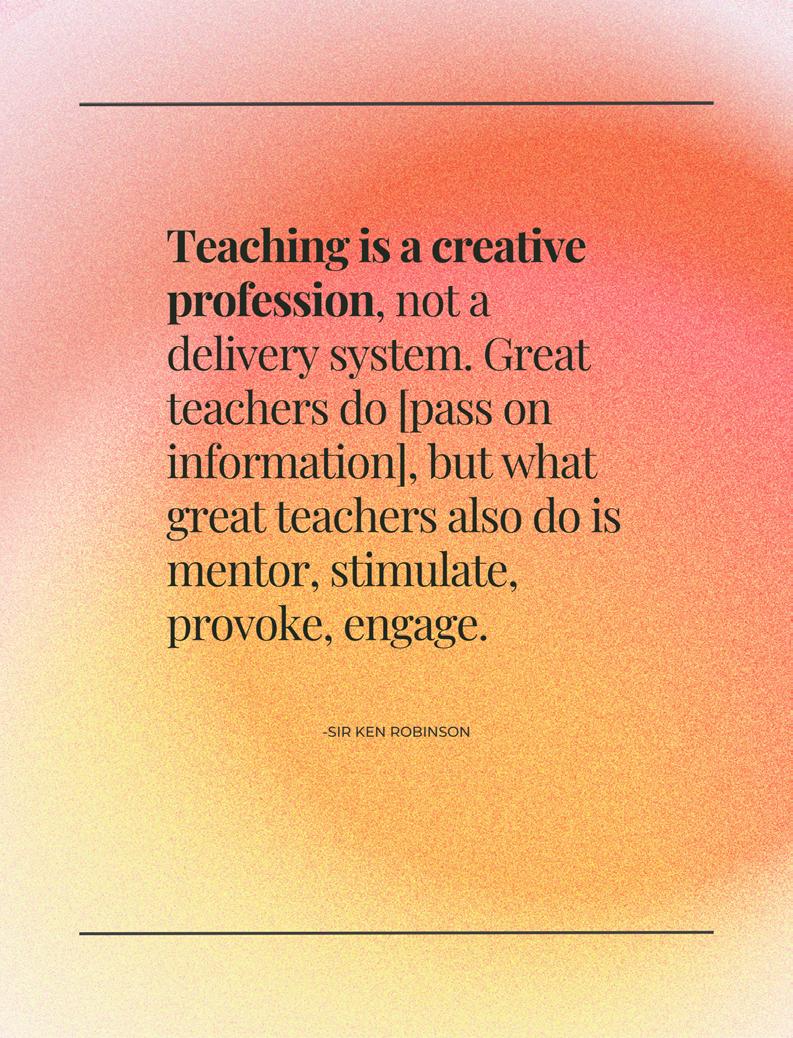
15
The 3 E’s – Education, Experience and Execution
Knowledge is Important AND Insufficient

Learning is important. The more basic information we have stored in our brains and accessible, the quicker we can use that information to make decisions. Storing that information requires memory hooks, acronyms, metaphors and stories to make recall easier. Long-term memory and the ability to retrieve information is helpful when facing problems.
Another important element of making decisions is in the procedural memory, having strategies to use the information. Adding heuristics to your skill set provides options to understand and solve issues quicker. The more strategies and the options to manage outcomes gives us flexibility. Trial and error are essential to eliminate strategies that do not work and keep the ones that have produced better results.
Learning from fields outside our primary position, research and practice is necessary to extend our knowledge base. For example, as an educational leader, having a minor in
Several professional development studies have confirmed that without follow up, an idea becomes entertainment and doesn’t change behaviour.
Industrial Relations opened up a new avenue of learning for me. Yes, education can learn from business. Business can learn from education. Having more options provides more repertoire to choose from in solving challenges. Learning really is a both/and, not an insulated research base with a finite number of staff, students or leaders.
Traveling and talking to other cultures has always added to my repertoire and perspective. Talking to students, staff and community members representing diverse cultures increases my understanding. One size doesn’t fit all.
”Anyone who has had a bull by the tail knows five or six things more than someone who hasn’t."
–Mark Twain

Adding context and experience to the basic information is helpful. This is where we can multiply the positive effects of the knowledge we currently have. Not everything can be transferable. A great idea in Boston may not work as well in Albuquerque. At the same time, some of the strategies might be transferable to new contexts and communities. The more options we have, the more influence we have in the situation. My experience says one size fits one. Take the learning, adapt what you can and try it out.
“You Do Not Get Better Without Follow-Up”
–Ed Koch , Former mayor of NYC
Teachers Matter
16 BILL SOMMERS
BILL SOMMERS
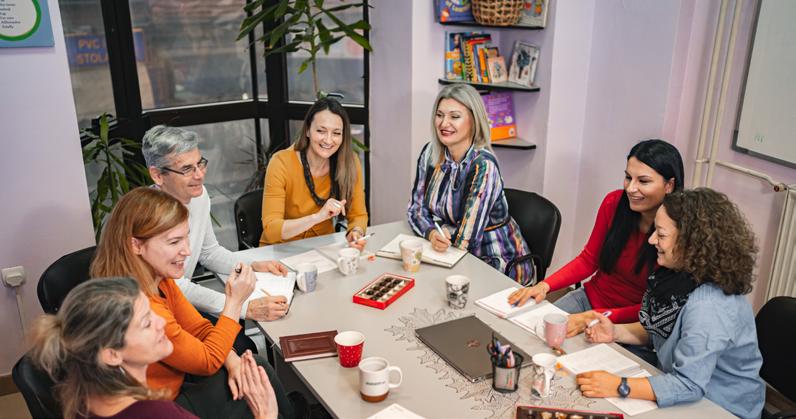

The above quote is in Marshall Goldsmith’s book and reiterates what Joyce and Showers have published in educational research. Without follow up, not much changes. Learning and coaching are only as effective as the active use of ideas and processes. Several professional development studies have confirmed that without follow up, an idea becomes entertainment and doesn’t change behaviour.
Coaching, whether individually or in groups, supports implementation. If you don’t try it, how do you know any idea works in your environment?
“Run the experiment.”
–Richard Sheridan, CEO, Menlo Innovations
Sheridan’s process of “Hey Menlo” is one of the best PLCs transferring information and experience that I have witnessed. Psychological safety is absolutely important to create a culture of learning and sharing.
Final Thoughts:
Learn as much as you can, from anyone who has good ideas and anywhere preferably in different locales and cultures. You get to synthesise the information.
Learn from those with experience in various contexts. As Isaac Newton said, “We all stand on the shoulders of giants.” Eleanor Roosevelt stated, “Learn from the mistakes of others. You can’t live long enough to make them all yourself.”
Learn to ‘do it’ and see what happens. Feedback provides data. Marshall Goldsmith coined the term “FeedForward.” The real question is: What are you going to ‘DO’ next with the information, feedback and new ideas?
“If your job is waking up the dead, GET UP! TODAY IS A WORKDAY!”
–Angeles Arrien

Dr William Sommers
Bill has been an administrator at the middle school, high school, central office and at the university level working in leadership preparation programs and doctoral faculties. As a teacher he worked with self-paced physics, math, and chemistry teaching methods. With over forty years of experience in teaching and leading schools, he has actively extended his learning from educational to include business models. He has been a consultant with Cognitive Coaching, Adaptive Schools, Brain Research, Poverty issues, Leadership Development and Conflict to Consensus models.
He can be contacted at: sommersb4@gmail.com
17
VANESSA MCHARDY
Moving Students with Anxiety Forward
Students Need to Feel Safe First
Everyone these days seems to be suffering from anxiety, presenting a problem: We are at risk of labelling something that is a very normal feeling into a disordersomething abnormal and to be avoided.
Ask anyone who has done anything outside of their comfort zone and they will describe anxious sensations. “You have anxiety,” sounds like a problem, but being anxious is well within the normal range of being human. Pathologising anxiety is not helping anyone. I suggest that we don’t want to avoid these feelings; rather, we want to embrace them.
Recently, I was working with a young person who did have severe anxiety, triggered by their presence in the school environment. It was extreme and permeated all areas of
their life so that their life became more like a prison of limitations than one of living. Whilst working with them I was very clear that their body did truly feel awful when it was in the throws of feeling anxious. I knew they likely experience the full fight or flight system being activatedheart pumping, sweating, narrowing of vision, catastrophic thinking and more. That is horrible.
Whilst we were working through a particular scenario that was going to be very difficult for them, as they described their sensations in their body, I shared that this was what excitement felt like and that fear and excitement were on the circuitry in the brain and body. I shared how very famous actors puked before going onto the stage, which I find incredible that your body could be convulsing in

18
fear, yet because they knew their why: “I know acting and performing is exhilarating and serving an audience.” The actor moves through it. They stand on the edge and step off.
I saw a clip on YouTube the other day of a woman sharing her way of “standing on the cliff and jumping.” She shared that either way, you are going to get up. You might fly. You might fall. Either way, you will get back up. Trying so desperately to avoid uncomfortable feelings simply makes those feelings bigger and more uncomfortable.
Trying so desperately to avoid uncomfortable feelings simply makes those feelings bigger and more uncomfortable.
So what is the way forward? Our children are showing a lot of signs of experiencing anxiety. They are expressing this through self harm and eating disorders, both of which have massively increased in the last few years.
One of my friend’s teenage daughters has suddenly started having very intrusive thoughts about death and dying. I believe that Covid-19 is partly to blame. She was only ten years old at that time and was alongside all of us on that awful roller coaster ride like none of us had ever known, taking lives all around us. In every area of our lives was fear and death. It was all that was spoken of for two solid years. Then there was the war on Ukraine. Now, the war in Gaza with children being killed, not to mention the cost of living crisis.
Everything is back to normal regarding going to school, which means everyone has relaxed a little and what happens when we relax a little? All the things you have been tightly holding onto come to the foreground. Our kids have had a very tough time for a really long time. Those affected by natural disasters have a whole other layer of stress added to their psyche.
The way forward is actually very, very simple. For many teachers it is too simple and they dismiss it. The way forward is to help make our children feel safe within
VANESSA MCHARDY
themselves and in their environment. Not wrap the kids up in a blanket and protect them from everything unpleasant or scary. That does the opposite. I heard the other day that it is no longer helicopter parenting but concierge parenting that is taking hold of the nation's parents. The concierge parent removes all obstacles so that the child does not feel pain or fear - that is not the way forward!
To actually make them feel safe within their own being is to enable them to have natural resilience. We don’t have to teach it. Even babies have bundles of resilience; Otherwise, we wouldn’t know how to walk!
We need to offer opportunities for students to reconnect to what is innate within. To have the ability to rest deeply and breathe gently. To help them reconnect to their original breath, one of stillness and exquisiteness. This is what we need to do actively every single day, many, many times a day.
How schools can do this is again very simple. Start with our communication system - a simple rating scale of 1-5. How are you feeling? As students come in, they will know to answer each day by showing the teacher with their hand what number they are on the scale.
1 – Great!
All the way to…
5 – I’m having really big feelings.
Then, they did a gentle breathing exercise and were asked again where they were on the scale. If they were still at a five, then there were clear options defined to choose from for support. Posters and visuals were used to help remind what each number represented, and most importantly, gave the space once a week to draw out how they were feeling in gingerbread person outlines. It works because it is simple and nonverbal so it is fully inclusive of all.
Make sure you have a space in the room that has soft furnishings cushions, stress balls and perhaps even noise cancelling headphones. Sometimes, a reading corner can double as the connection corner. Take time to allow for students to tune in and connect to their body - how it feels when they are warm, cold, tight, soft, hard, tingly, etc and to tune into their feelings at each of those times. Simply acknowledging how one feels is a very powerful tool to build connection and feeling inner safety.
Top Tips for Reducing Anxiety
1. Look down at your chest and torso area and say out loud, “I am not being chased by a tiger.” Then do horse lips (Purse your lips together and blow air out so that your lips vibrate.) I have been doing this for a few years and it worked so effectively and then I was at a conference last year with Nathan Wallis speaking and
19
MCHARDY

he shared that your brain listens to what you are saying more than to what you thinking. This explains why an exercise like horse lips can bring me out of a stress state so effectively. My brain listens to the fact I am not in a physical, threatening situation and turns off the alarm system.
2. Walk! Try to walk every day for yourself, for at least 15 minutes. The benefits from walking are plentiful and the best part is that it just requires movement. The key for this to be a stress reducer is to be very present with your walk. Feel your feet on the ground, feel the movement of your arms as they swing and the delicacy of your fingertips as they brush past your clothing. The more you focus on the sensation the less in your head you will be about other things. Walking for 15 minutes with conscious presence is infinitely more supportive than 45 minutes with a critical brain going round and round in your mind.
3. Consistently do one thing a day that your body loves. For example, I end my day with a warm/hot cloth on my face. This allows my whole body to release any tension and soaks up the steam and heat.
4. Keep hydrated! This is so important. Most of us are dehydrated, which puts our body into stress.
5. Look up and out to the horizon. This works on the very primitive part of the brain that is essentially scanning the horizon for threat. In our modern world, we spend a lot of time looking down and into screens. Instead, look up and take the opportunity to breathe gently. Place your hand on your chest area and let your body settle.
6. Do connective tissue exercises. The connective tissue loves small, rhythmic movement. These can be as
simple as raising your toes up and down gently and rhythmically.
7. Draw it out! Making a mark with your hand and a writing utensil like a pen, pencil or crayon is a primitive need. Movement and expression with drawing does something for our brains that is very healing.
All these regulation and connection exercises are most effective done several times a day - kids of all ages love these (Even teens!) They especially love it when you do the exercises alongside them. (Which is a win-win situation!) Regulation, connection and expression are king if you want to create an environment where children feel safe in their body. When they feel safe, they will be ready to learn!

Vanessa McHardy
Vanessa McHardy is a leading Integrative Child & Adolescent Psychotherapist, UKCP registered with 20 years experience, with a speciality for bringing Life Skills for Mental Health and Wellbeing Programmes to school communities. Vanessa has returned to New Zealand after 30 years in the UK, She has a wealth of experience of delivering these services with a focus on wellbeing. She works globally delivering, online to Europe, America, Hong Kong and Australasia.
For more, visit www.lighteducationtraining.com
Teachers Matter
20
VANESSA
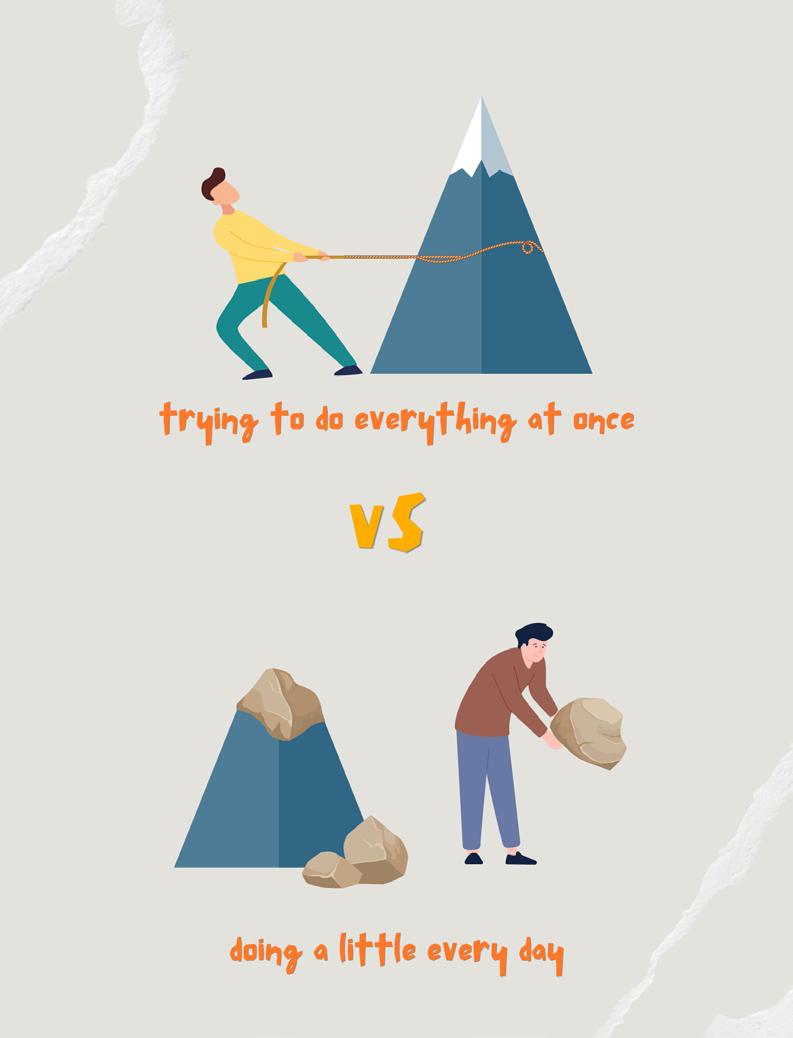
21
Put the Pen to the Paper
Tea Bag Wrappers aren’t the Best Note Taking Supply

Have you ever received a note from a parent on a tea bag wrapper? If my grandad were sending the note, you might have. He carefully opens his teabag each morning and then keeps the empty paper wrapper on the table in a neat stack for when he needs to write something down. I’ve been given more than one tea bag wrapper with important information.
You may not use tea bag wrappers, but I bet you have a favorite tool for note taking. It may be your phone, but is that what you let students use in class for taking notes?
Notetaking is the first study skill I teach students as a study skills tutor. It’s a skill that can improve their learning in every class, so it’s where we start with my Love to Learn study skills program.
You may think typed notes are better, but there’s too much brain science out there supporting handwritten notes at least as the first iteration.
22 Teachers Matter
JESSYKA COULTER
JESSYKA COULTER

Before asking your students to take notes, encourage them to use the right supplies. I suggest students use folders with the brads (fasteners) and notebook paper instead of spiral notebooks. I want them to be able to find their correct notes quickly AND not have a backpack full of loose papers. I’m also a big believer in taking notes with pen and not pencil. You may think typed notes are better, but there’s too much brain science out there supporting handwritten notes at least as the first iteration.
Did you know that…
• People remember things better after they’ve written them down? (More so than when they’ve typed them.)
• Writing things down asks your brain to see what you’ve written, to make your hand move the pencil to create the letters, and consequently, your brain has more touch points to remember the information you recorded?
• In Japan, a study was done to compare the speed of taking notes by hand or typing them? Taking notes by hand was faster. There’s no trying to find a special key when you’re using a pencil and paper. Underline it. Put a checkmark or star on it. You only need one hand and one pencil.
Note taking has value for you as an adult and especially for each of your students.
When it comes to teachers, students and notes, there are a few things I teach my students. I hope they’re true with you because I want the teens I work with to be successful in your classes. I know notes will help them.
I tell students to have pencils and paper every day in your classes. My hope is they take notes every day in every class. I want them prepared when you say, “You should write this down.” When they know something is essential to their understanding, they can successfully complete the homework and study for the test. Unfortunately, most teens don’t know how to take notes and rely on you to guide them or even tell them exactly what to write down.
I also tell students to review their notes. Although brain science says they’ll remember better because they wrote it down, I want them to have notes they actually use. I encourage them to take just 5 minutes to review them each day. That way when it’s a couple days before a test and you say, “This, this and this will be on the test,” they’ll be ready to mark their notes and write down anything they might have missed or misunderstood.
There’s also a chance you’re one of the teachers who lets students use their notes on a test or even one side of a 3 x 5 inch index card. Encourage your middle school and older students to take advantage of your generosity.
And, finally, let students see you take notes. I’ve had many teachers who write notes to themselves on the board during class. Your students need to know that taking notes isn’t just for students.
By the way, if you want to play with your students just a little bit, I know a man with a lot of tea bag wrappers. Before your next test, you could give each student a tea bag wrapper to write notes on he or she can use on the test.
Which students would take you up on your offer?
Wishing you all great success!

Jessyka Coulter
Jessyka Coulter is the CEO and Founder of Ace Cookie Tutoring. Her company offers study skills, tutoring and executive functioning coaching through her Love to Learn program. She knows most schools offer a one-size-fitsall curriculum that doesn’t always meet every student’s individual needs. When teens don’t know HOW to learn, they don’t enjoy school, but by discovering HOW to learn through the study skills Jessyka teaches, they love to learn!
Contact her at acecookietutoring@gmail.com
23
BARRY COOPER
Harnessing the Power of Artificial Intelligence
How to Build Context, Connection and Communication

Inan AI rich future, a cultural and human education is vital to provide the context in which information is seen. Cultural education is one pathway to greater understanding, bringing together perspectives from across the planet, from across nations, religions, ethnicities, social and economic groups, politics and philosophies. Cultural and human education gives us a lens through which we can examine the world with clarity while creating a society with a greater sense of their humanity.
More than our different lives, backgrounds, philosophies and histories, it is also about examining the skills we need to live. Our students have so many things they need to learn that AI can’t teach through a screen:
• How to play in a team,
• How to lead,
• How to ask a question,
• How to understand where power truly lies,
• How to use critical thinking,
• How to problem-solve,
• How to develop and use research skills,
• How to communication, and
• How to effectively collaborate.
If we are to harness AI properly within education we must understand the possible ramifications of its wider, medium to long term use and educate students accordingly. We will have to create an environment for success that comes in three parts: context, connection and communication.
We are, rather hubristically, recreating a classical approach here in the twenty-first century. This three-stage approach is in fact a new Trivium: grammar, logic and rhetoric. Denoted as the word ´trivium’ in the Middle Ages, these foundational skills were seen as the lower order of the seven liberal arts: the other four being Music, Geometry, Arithmetic and Astronomy. These language skills (grammar, logic and rhetoric) underpin our new concepts for the AI Age: context, connection and communication. They are now not just about the structure and use of language, but about the structure and understanding of the world.
Context, much like Grammar, is the foundation. In this case, it is the foundation for education in the AI world. Without cultural, socioeconomic or historical context on which to ground our decision making, we cannot move beyond the information we are presented with by generative AI. We certainly cannot ask for the right things or adequately assess the output of AI when we are presented with the returns from our prompts.
Teachers Matter
24

We develop the context for our students’ understanding, build their connection to the world and their humanity - and then pass them the tools to speak and understand the world as it changes at its rapidly increasing pace.
Connection is the ability to work with others, but also to be connected to the world. In an increasingly siloed workspace and the advent of online working and schooling this is important to not only temper the skills already there, but to learn further from others and through others. The perspective of generative models will reflect back at you the prejudices of your questions and your approach; however the counsel of a wise friend may take you places you had not even considered.
Communication is very similar to rhetoric: the explanation of our ideas, but also understanding that communication is not just about words on a page or a speech on the air. How we deliver information to one another is changing every day,
verbal spoken, written, multiple languages, interpersonal, intra personal, nonverbal, visual, mathematical, scientific, artistic, musical communication are all parts of our every day. Education in the information age has to provide the skills to hone a voice to a particular time and place.
The challenge is massive and the solution, in my view, is a return to structured appreciation of education, but with the net extended far beyond what a classical, traditional or even modern education provides. We develop the context for our students’ understanding, build their connection to the world and their humanity - and then pass them the tools to speak and understand the world as it changes at its rapidly increasing pace.

Barry Cooper
Mr. Barry Cooper’s educational career spans 20 years, 3 continents, and 4 prestigious schools in London, Edinburgh, Shanghai and Dubai. Most recently, he shaped the academic curriculum for the newly launched Brighton College Dubai, while also finding time to create and curate a new Arts festival. Previously he championed the IB Diploma programme for History at Wellington College Shanghai, his first international move after 8 years on the leadership team at leading Scottish boarding school Loretto just outside Edinburgh. He started his career at Epsom College, as teacher of History and a residential Assistant Housemaster.
25
BARRY COOPER

Cultivating a Growth Mindset
The Key to Resilience
Teaching is a life-long commitment towards positively shaping the lives of every individual under your tutelage so that they can become great leaders of tomorrow.
“Teachers support learners in their quest for new knowledge on a specified set of subjects. This applies to students of all ages, from preschool to post-graduate learners.”
- Indeed, job/recruiting website
In order to become an effective teacher, you must cultivate a growth mindset and show resilience. With a growth mindset you set yourself up for greater success potential. We all have areas of our respective worlds where we have both a growth and fixed mindset - none of us escape this. The key is to identify when we are ‘stuck’ in a fixed mindset and work to turn that around so that we can benefit from the value of a growth mindset.
Making
sure your students receive the best education possible and fostering a growth mindset are two of your most important responsibilities as a teacher.
26 SALLY FOLEY-LEWIS
SALLY FOLEY-LEWIS

Education is a landscape of constant change and challenges. No need to tell you that, right?!? A growth mindset, the belief that abilities can be developed through dedication and hard work, is your armour in the face of adversity. By cultivating a growth mindset, you become resilient.
According to APA (American Psychological Association), “Resilience is the process and outcome of successfully adapting to difficult or challenging life experiences, especially through mental, emotional and behavioural flexibility and adjustment to external and internal demands.”
Fostering a growth mindset within yourself and your students can contribute significantly to overcoming challenges, adapting to change and driving continuous improvement. Here are practical steps to cultivate a growth mindset:
1. Embrace Challenges as Opportunities
• Mindset Shift: View challenges not as insurmountable obstacles but as opportunities for learning and growth.
• Action Steps: Tackle challenges head-on, emphasising that it’s okay to make mistakes as long as you learn from them.
2. Value Effort over Inherent Talent
• Mindset Shift: Shift the focus from innate abilities to the effort invested in achieving goals.
• Action Steps: Acknowledge and celebrate hard work and dedication, both within yourself and your students. Highlight instances where perseverance led to success.
3. Learn from Criticism
• Mindset Shift: See constructive criticism as valuable feedback for improvement, not as a personal attack.
• Action Steps: Encourage a culture in the classroom where feedback is constructive and viewed as an essential part of growth. Model receiving and giving feedback with a positive and growth-oriented mindset. Improve, engage and drive performance through effective and engaging feedback.
4. Celebrate Other Teachers’ Success
• Mindset Shift: See other Teachers’ success not as a threat but as inspiration and an opportunity to learn.
• Action Steps: When your co-teacher succeeds, celebrate their achievement. Use it as a moment to share insights and lessons learnt. Emphasise that success is not a finite resource.
5. Foster a Love for Learning
• Mindset Shift: Cultivate a passion for learning and improvement in yourself and your students.
• Action Steps: Encourage continuous learning through workshops, training programs and skill development initiatives. Share articles, books and resources that inspire a love for learning. Encouraging your students to work on themselves so they can become confident and capable leaders of society, regardless of the function they hold, is a part of teaching. Making sure your students receive the best education possible and fostering a growth mindset are two of your most important responsibilities as a teacher. This will help them become resilient and prepared to face the challenges of the real world when they are left to fend for themselves and forge their own paths.

Sally helps middle managers be productive leaders. She is a global, multi-award winning Certified Speaking Professional, who’s helped over 20,000 middle managers from diverse industries, locally and globally. With her unique blend of experiences, exceptional qualifications and humour, Sally’s keynote presentations, workshops and resources inspire, transform and deliver results.
She can be contacted at sally@sallyfoleylewis.com
Sally Foley-Lewis
27
You’re Making a Difference
A True Story to Inspire
If you’re like me, you have the thought daily in your mind, “Do I really make a difference?” As an educator you spend countless hours preparing lesson plans, attending professional development days to learn new skills to implement in your classroom and somehow you juggle 18 to 30 different personalities for nearly 200 days! Burnout, stressed and crossing our fingers hoping everything will work out takes a toll on one’s ability to see the bigger picture sometimes. This is the life of an educator. If this sounds like you, then you’re probably going to want to read this article.
I’m here to tell you that you do make a difference! You are the real first responder, as you impact lives daily through your superpower of educating youth. Many wouldn’t last a day in the classroom due to all the different stresses. But you are resilient, you are essential and you do make a difference.
I was recently having a bad day where I was second guessing my impact on students’ lives. Yet, I kept this quote in mind, “You’re allowed to have a bad day, but don’t let your bad day have you.” I was invited to speak to a kindergarten class on the subject of Positive Affirmations. When I entered the classroom, I was so stressed from the day, that I forgot to introduce myself to the students. I just went right into the lesson.
The students were doing great, but I had one student that wasn’t paying attention. This student’s name was Michael. We all have a Michael or we have seen a Michael - that student that is rolling on the floor, won’t pay attention and is trying the little bit of patience you have left. Michael just wouldn’t listen, and I had enough. I spoke to Michael sternly and said, “Michael, I know you can do better than

28 CALEB WESCO
“But you are resilient, you are essential and you do make a difference.”

this.” Michael looked at me with these big brown eyes - our eyes locked and Michael knew I was not playing with him.
Michael sat up straight and folded his hands in his lap. As I began to wrap up the lesson, I noticed Michael’s eyes were glued on me. He seemed to be hanging on to every word I was saying. I thought to myself, “If I had the energy to talk to him sternly, then I also have to let him know he’s doing a good job, too.” I said, “Michael, I am so proud of you! Your behaviour has improved big time!” Michael smiled and he listened for the rest of the lesson.
Now, remember when I said that I forgot to introduce myself to the class? Well, as the kids were heading back to their seats, I turned and on the back wall was a picture of Dr. Martin Luther King, Jr., whom they must have just finished learning about. As I turned to head out of the classroom, I felt a pair of legs and arms wrapped around my own leg. I looked down and guess who was hugging me? Michael! He looked up at me with those brown eyes and said, “Thank you Dr. Martin Luther King Jr.” I gently explained my real name and thanked him for such a large compliment. As I left the building, a wave of emotions hit me! I kept it together until I got to the car. But when I closed my door I cried. I thought to myself, “The lesson moved Michael so much that history jumped off the page and landed right in front of him.” In Michael’s innocent moment, he gave me
the inspiration I needed to continue giving my all in the classroom to each and every student.
Educators, there are times we have bad days. There are moments where you just feel like throwing in the towel. But remember, there are little Michaels out there that need you. They are hanging on to every word you say. You are changing lives. You are making a positive impact. You are making a difference!

You can contact him at: c@calebwesco.com
Caleb Wesco
Caleb Wesco is a motivational speaker from West Palm Beach, Florida, in the USA. Caleb’s target audience are schools at any level, as he looks to keep senior leaders, teachers and students motivated on the road to higher education.
29 CALEB WESCO
KARI SUTTON
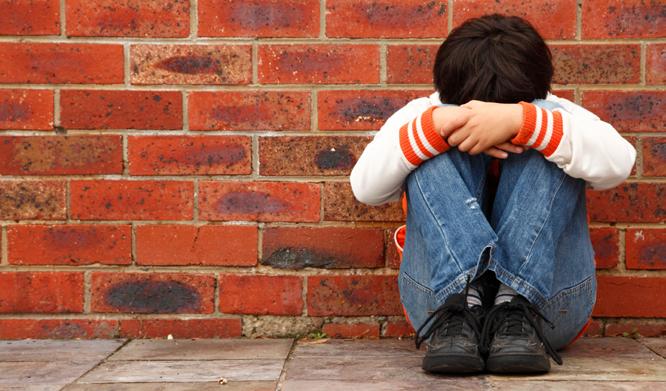
Helping Children Handle Bullying
3 Simple Strategies for Students
In today’s society bullying has become a common part of childhood. In countries throughout the world, national surveys indicate that the majority of children and teenagers have experienced some form of bullying in the past 12 months. One in four reported they had been verbally bullied, while one in seven experienced physical bullying. Up to one in ten reported experiencing a combination of both. Even the Duchess of Cambridge, Kate Middleton, was bullied at school and is now passionate about helping support children’s mental health and wellbeing.
Bullying has three main features:
• It involves a misuse of power in a relationship,
• It is ongoing and repeated, and
• It involves behaviours that can cause harm.
Behaviours that do not constitute bullying include:
• mutual arguments and disagreements (where there is no power imbalance)
• not liking someone or a single act of social rejection
• one-off acts of meanness or spite
• isolated incidents of aggression, intimidation or violence
These encounters need to be addressed and resolved but are not classified as bullying behaviours. Research has shown that before the age of eight nastiness is largely unintentional due to young children’s lack of recognition about how their actions impact on others. After eight years of age, however, their cruelty becomes more intentional since, from this age, the majority of children are aware of the consequences of what they are doing.
Numerous studies have found that children who have experienced severe bullying are at higher risk of developing significant mental health problems, anxiety, depression and suicidal ideation. Therefore, it’s important to identify if bullying is occurring and develop a plan to deal with it immediately. Warning signs of bullying can include:
• feeling sick, stomach aches, headaches, unexplained injuries,
• loss of personal items such as books, clothes, phones, jewellery, swimmers,
• declining grades, not wanting to go to school, a change of sleeping or eating habits, loss of interest in doing things socially with friends, decrease in self-esteem, increase in negative self-talk, self-harm behaviours
30 Teachers Matter
“Listen to them and let them know that you believe them.”

Many adults often feel unsure of how to help children navigate this social nightmare. They fear for the child’s wellbeing but feel powerless to change peer dynamics and this often leaves them feeling helpless. One of the most common reasons parents came to see me in my role as a guidance counsellor was to ask for advice on how they could help children handle a bullying situation. The good news is that there are three simple ways that you can help children handle bullying.
1. Listen to them and let them know that you believe them. Communicate that you are sorry for what they are experiencing and support them to problem-solve solutions when they are ready for that. Let them know you’re going to help them figure out a way to deal with it.
2. Reinforce that reporting unkind, cruel behaviour is not snitching. Telling someone about mean actions is the right thing to do, including when they witness other kids being bullied. Bullies function by making their victims feel powerless, by telling an adult about bullying kids can start to re-balance the power dynamic and the bully immediately begins to lose power. Alerting an adult is not a weakness, but rather a brave, powerful strategy.
3. Teach kids about using assertive communicationsimple, unemotional language that lets the bully know that they do not intend to be a victim. Coach them on how to use these in different situations. Help them practice using body language that reinforces their words such as maintaining eye contact, keeping their voice
calm and even, standing up straight with shoulders back at an appropriate distance from the bully and using the bully’s name when speaking to them. These actions portray a calm confidence and a bully will detect less potential for exerting power and control. Practice role playing different scenarios and how they could respond to a bully, so your child gets comfortable using these skills.
By working together with children and using the above strategies and ideas, you can help them cultivate a resilient mindset that prepares them to handle any bullying they may encounter.

Kari Sutton
Kari Sutton is an educator, speaker and author who has helped over 25,000 children, parents and educators with evidence-based strategies, tools and approaches to foster children’s positive mental health. She helps others to plant the seeds of resilience, emotional wellbeing and mental fitness in our children.
For more information, visit www.karisutton.com
31 KARI SUTTON
From Plumbing Pipes to Pedagogy
Featuring Problem Solving Processes in the Classroom
In education, problem-solving is a foundational skill for navigating the challenges of an ever-evolving world.
Recently, problem-solving loomed large in my home! I renovated my bathrooms and was thrilled with the outcome, except for one thing! Our shower? Let’s just say it had a mind of its own. One minute, we were singing in the rain, and the next, we were doing the ice-bucket challenge without signing up for it!
Assuming it was a faulty mixer fitting, we called a plumber to replace it. Instead of going for the easy fix we suggested, our plumber channelled his inner MacGyver. Armed with gadgets and gizmos, he went all CSI on the case, measuring water temperatures in different areas of the house and unravelled the mystery like a pro. Our house was hiding a secret: it has not one, but two competing hot water systems!
He separated them, and the shower finally behaved itself. It hit me that this plumber wasn’t just fixing pipes; he understood problem-solving as an art form.
Applying Lessons to Education:
This story has relevant implications for educators aiming to cultivate problem-solving abilities. Students of all ages will enjoy engaging in similar hands-on problem-solving. For younger students, a task might be the best way to join cardboard boxes to make a castle for a stage prop. Students might consider different perspectives to create a workable classroom agreement about community behaviour in their school. As they progress, challenges may evolve into innovative solutions to overcome environmental issues. Both our future and our present need good problem solvers!

32 LILI-ANN
KRIEGLER
“By avoiding assumptions, applying perseverance and using a systematic approach to problem-solving, we equip students with the tools they need to thrive in a complex and everchanging world.”
Key Problem-Solving Principles:
• Gather Input and Information: Encourage students to gather all relevant information about the problem, considering different perspectives and sources of data.
• Take a Systematic Approach: Teach students to methodically test hypotheses and iterate on solutions, embracing trial and error as part of the learning process.
• Document Discoveries: Record ideas using written and spoken media as well as creative arts.
• Use Tools: Use any scientific or other tool that can help solve a current issue.
• Analysis and Evaluation: Teach students to analyse and evaluate the information they have gathered, identifying patterns, root causes and potential solutions.
• Combination of Knowledge and Experience: Encourage students to draw from their past experiences, expertise and understanding of similar situations to generate several potential solutions or approaches.
• Creativity: Adopt creative thinking techniques, such as brainstorming, mind mapping, or lateral thinking to determine consequences and think outside the box.
• Reach the Best Solution: Guide students to generate the best possible solution by evaluating the available data and considering practicality, effectiveness and feasibility. By avoiding assumptions, applying perseverance and using a systematic approach to problem-solving, we equip students with the tools they need to thrive in a complex and ever-changing world. Problem-solving isn’t only about finding answers; It’s about embracing resilience, collaboration and creativity. Let’s empower the next generation to tackle challenges with confidence, ingenuity and a passion for making a difference.


Lili-Ann Kriegler
Lili-Ann Kriegler (B. A Hons, H. Dip. Ed, M.Ed.) is a Melbourne-based education consultant and awardwinning author of Edu-Chameleon and Roots and Wings. Lili-Ann owns Kriegler Education and writes to share the wisdom she has acquired through her training and 30 years of experience in education. She is a child, parent and family advocate who believes that education is a transformative force for humanity.
More information can be found at: www.kriegler-education.com/
33
LILI-ANN KRIEGLER
MICHAEL GROSE
Not Enough Time for Student Leadership?
Developing Student Leadership Quickly, Easily and Effectively
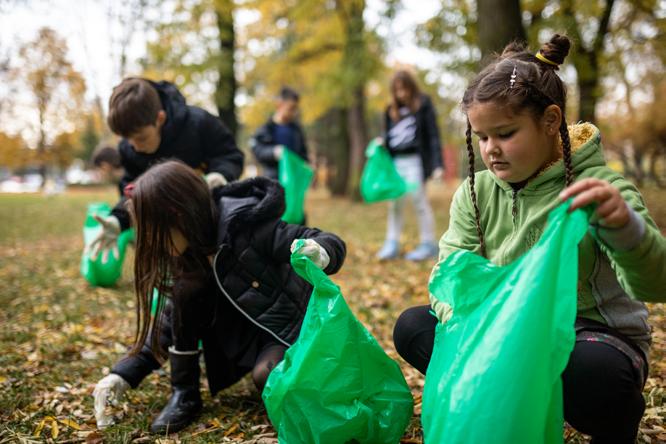
The best way to develop leadership in your school is through explicit classroom teaching. I’ve spent 30 years helping primary schools train their student leaders. In that time, I’ve assisted hundreds of teachers in Australia, Singapore and Britain to bring leadership to the fore. I’ve been in primary schools that do leadership well, and not so well, including student leadership in the classroom. Here’s what I’ve learned.
1. It’s not as hard as you think.
We make leadership seem harder than it is. There are 5.5 billion Google searches each year for ‘leadership.’ It’s one of the most searched terms on the Internet. Why? It’s considered essential for individual, community and corporate success. It’s also thought to be difficult to learn, develop and practise.
There’s a stigma around something that’s so elemental and basic to human survival that whole industries have developed to support it.
Remove the complexity and you’ll find that most leadership behaviours and qualities are those that we are always instilling in kids – kindness, organisation, empathy, taking initiative and reflection, in addition to others.
Here’s the biggest mistake.
It’s a mistake to package leadership as an added layer of behaviours and qualities to teach kids. Instead identify, name and amplify the existing behaviours and attitudes in the name of effective/great/wonderful student leadership. Teaching student leadership in the classroom is within every teacher’s grasp.
Teachers Matter
34
2. Leadership teaching starts with a leadership mindset.
There’s little difference between friendship and teamwork. Yet one is a social skill and the other is a leadership skill. Both require similar qualities –selflessness, a willingness to give something of yourself and having the back of others. The real difference lies in the mindset that you bring.
If social skills (social and emotional learning) is your frame, you’ll see those behaviours as friendship skills. However, if leadership is your frame, then you’ll see teamwork skills. Bring a leadership frame into the classroom and a leadership mindset will follow. That makes teaching student leadership in the classroom doable.
Acts of leadership happen all the time, but they are often seen as something else. Recognise leadership for what it is and acknowledge it when you see it.
3. Look for leadership moments.
“Cometh the moment, cometh the leader.”
I love this quote. Two things need to happen for it to be true in a school. First, teachers need to provide plenty of opportunities for students to flex their leadership muscles. Second, teachers need to recognise leadership when it occurs. A student that volunteers to hear younger students read? That’s leadership. A student that invites a less popular student to play a game? That’s leadership. Acts of leadership happen all the time, but they are often seen as something else. Recognise leadership for what it is and acknowledge it when you see it.
4. Play a junior version of the game in the lower years.
Leadership comes into its own in the senior primary school years.That’s smart since developmentally, 10–12year olds are the primed targets for leadership. Student
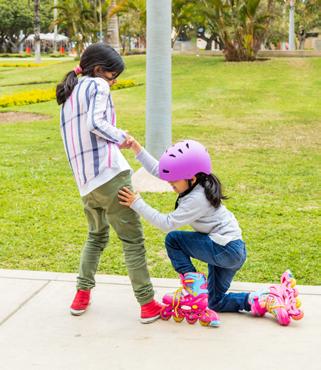
leadership in the classroom happens in the lower years, too. Borrow from the major sporting codes and use a modified version of the leadership game. (Think Auskick, Kanga Cricket and Little Kickers.) Focus on key student leadership activities (e.g. speaking in front of others, organising a sports event or community ambassador) and simplify each in the earlier years.
5. Develop proprietary leadership language.
Shared language creates a strong school culture. This idea was drummed into me by my mentor, US-based educator Michael Grinder. He was right. Primary schools that value leadership develop shared language around key leadership qualities such as problemsolving, teamwork and capacity-building. This language has meaning for each school. For instance, in one Young Leaders school, “Lead away,” was repeated by teachers and students from Foundation to Year 6. The term is a simple encouragement for students to take initiative when a situation presented itself. The minute I heard a house captain use this term when working with a small group I knew that “Lead Away,” was embedded in the school’s culture.
Figure out the core leadership terms and phrases you want kids to learn and then do what primary schools do so well - share the language visually, orally and repeatedly through all your media until the language sticks.
35
MICHAEL GROSE

6. Create leadership systems.
Student leadership thrives when you create systems that support its growth. James Clear, author of the fabulous book Atomic Habits, says, “When we create systems around our habits these patterns become unbreakable.” Don’t just build leadership habits in students and hope that they become patterns of behaviour. Create systems that create leadership habits and patterns.
The use of election speeches is an example of systematic leadership development. Every year students must give a speech (which is a leadership behaviour) to win enough votes. Speech-making is built into the leadership system. Schools that do leadership well have many systems embedded into school life that promote essential leadership habits.
Start with the systems you have in place and gradually add to them over time.
7. Make leadership easy, daily and satisfying.
The best teachers make it easy for kids to behave well, learn and lead. They set the conditions for each to seamlessly occur. They cue kids to behave in certain ways. They pitch teaching at the right level. They give students opportunities to lead, to reward success and to improve.
When teaching leadership in the classroom, expect leadership, like good behaviour and learning, to be
on display every day. Make sure leadership activities are fun, projects are satisfying, and improvement and success is celebrated.
Hit the easy, daily and satisfying trifecta and leadership in the classroom or school will soar.
Finally…..
There you have it. Student leadership is alive and well in many schools. Hopefully, it is in yours. I’d love to hear your student stories as well. That’s it. Now lead away.

Michael Grose is the founder of the Young Leaders Program, an in-school program designed by teachers that builds strong cultures of student leadership in primary schools. An experienced educator and popular presenter Michael is a PSA Australian Educator of the Year winner and is a Hall of Fame member of the Professional Speakers of Australia.
Find out more at www.youngleadersprogram.com.au
Teachers Matter
Michael Grose
36
MICHAEL GROSE

37
KAREN TUI BOYES
Master the Art of Essay Writing
Clear Steps to Achieve Your Best Work
Do you have an assignment looming? Are you staring at a blank screen, unsure of where to start? Crafting an essay might seem like a daunting task, however, there are structures, tips and sentence starters to help! Read on…
An essay has three main parts. An introduction, the body paragraphs and the conclusion.
There are many different analogies to understand these parts. Here are two:
The Burger Analogy:
Introduction (Top Bun): Just like a burger needs a top bun to hold everything together, an essay needs an introduction to set the stage for what’s to come.
Body Paragraphs (Fillings): Each body paragraph is like a layer of toppings on a burger. Each set of details adds flavour and substance to the overall composition of the essay. It’s the best part of most burgers and usually where you start writing.
Conclusion (Bottom Bun): Similar to the bottom bun that provides support to the burger, the conclusion wraps up the essay and reinforces the main points, giving it a solid foundation.

The Building Blocks:
Introduction (Foundation): Think of the introduction as laying the groundwork for your essay. Just like a building needs a strong foundation, your introduction establishes the purpose and direction of your essay - without a building’s foundation, it would crumble. The same is true for an essay without a strong start.
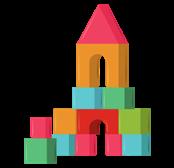
Body Paragraphs (Bricks): Each body paragraph is like a brick in the structure of your essay. They build upon each other, supporting your argument and maintaining the structure of your essay.
Conclusion (Roof): The conclusion completes the building by wrapping up your essay, providing closure and protecting everything underneath it.
Contrary to popular belief, one of the best places to start an essay is with the body. Just like preparing a hamburger – the filling is the best part so start there by knowing what details you want to discuss in the essay.
Constructing Body Paragraphs:
1. Start by Creating Draft Bullet Points: Before diving into writing your body paragraphs, it’s helpful to brainstorm and organise your ideas. Start by creating draft bullet points outlining the main arguments or points you want to make in your essay. These bullet points serve as a roadmap for your writing process and help ensure that your essay stays focused and coherent.
38 Teachers Matter

2. Group Similar Concepts or Points Together:
Once you have your draft bullet points, group similar concepts or points together to form the basis of your body paragraphs. This helps you organise your thoughts and ensures that each paragraph focuses on a single main idea or argument. Grouping related points together also helps create a logical flow between paragraphs.
3. Importance of Providing Analysis and Commentary: One of the most critical aspects of writing effective body paragraphs is providing analysis and commentary to strengthen your arguments. Simply presenting evidence or facts is not enough; you must also analyse and interpret the evidence to demonstrate its significance and relevance to your thesis.
Analysis involves breaking down your evidence and examining it critically. Ask yourself questions like: Why is this evidence important? How does it support my argument? What are the implications of this evidence? By providing thoughtful analysis, you show your readers that you have carefully considered the evidence and understand its implications.
Commentary goes a step further by offering your insights and interpretations of the evidence. It allows you to demonstrate your critical thinking skills and engage with the material on a deeper level. Commentary can include discussing the broader implications of your findings, addressing potential counterarguments or exploring the limitations of your evidence.
Contrary to popular belief, one of the best places to start an essay is with the body
4. Strengthening Your Arguments: By providing thorough analysis and commentary, you strengthen your arguments and make a more persuasive case for your thesis. Analysis and commentary add depth and complexity to your writing, helping you move beyond surface-level observations and insights. They show that you have thought critically about your topic and can engage with it in a meaningful way.
5. Demonstrating Critical Thinking Skills: Furthermore, providing analysis and commentary allows you to demonstrate your critical thinking skills to your readers. Critical thinking involves analysing information, evaluating arguments and synthesising evidence to form reasoned judgments. By engaging in thoughtful analysis and commentary, you show that you can think critically about complex issues and draw informed conclusions.
39
KAREN TUI BOYES
KAREN TUI BOYES
Demonstrating strong critical thinking skills is essential not only for writing essays but also for success in academia and beyond. It shows that you can approach problems thoughtfully, consider multiple perspectives and arrive at well-reasoned conclusions.
6. Use Transition Words
Transition words and phrases help connect ideas between paragraphs and within sentences. Examples include words such as however, in addition and therefore. These words enhance the flow of an essay and make it easier to read.
Most essays are expected to have a minimum of three body paragraphs and depending on your subject, level and word count, you might be expected to write five or more.
Introduction
Next work on your introduction. Think of it as your essay’s first impression. Just like meeting someone for the first time, you want to make it engaging and memorable. Here’s how:
1. Hook Your Reader: Start with something that grabs attention. It could be a surprising fact, a thoughtprovoking question or a compelling quote related to your topic. There are several sentence starters you might use to do this. Examples include:
- Did you know…
- Have you ever wondered…
- Do you ever think about…
- Why might…
- Have you ever considered…
- Is there a correlation between…
For instance, if you’re writing about climate change, you might begin with a shocking statistic like, “Did you know that the polar ice caps are melting at an alarming rate?” Or, you might write, “Have you ever wondered what goes on beneath the surface of our oceans?”


2. Provide Context: After hooking your reader, give them a brief overview of the topic. Set the stage by providing background information, explaining why the topic is important and what the essay aims to explore. This helps your reader understand the significance of what you’re about to discuss. Here are some ideas for sentences starters:
- Given the increasing awareness of…
- In today’s society…
- With the rise of…
- Amidst growing concerns about…
- In light of recent developments in…
- Given the current state of affairs in…
3. Thesis Statement: This is the heart of your introduction. It’s a single sentence that states the main argument or purpose of your essay. Make it clear and concise. It’s like the roadmap that guides your reader through the essay. For example, “In this essay, I will argue that Shakespeare’s portrayal of women in his plays challenges traditional gender norms.”
40 Teachers Matter
KAREN TUI BOYES

The Conclusion
Now wrap your essay up with the conclusion. Think of it as the grand finale of your essay. It’s your chance to leave a lasting impression and tie everything together. Here’s how to nail it:
1. Summarise Your Main Points: Start by briefly summarising the key points you’ve discussed in your essay. These are the bullet points or ideas you drafted at the start. Remind your reader of the main arguments and evidence you presented. For example: “In conclusion, it is evident that deforestation has far-reaching consequences for both the environment and human society.”
Other sentence starts for your conclusion include:
- In conclusion…
- In summary…
- In light of these findings…
- Taking everything into account…
- In consideration of the evidence…
- In light of these arguments…
2. Reinforce Your Thesis: Reiterate your thesis statement, but don’t just repeat it word for word. Paraphrase it and emphasise why it’s essential in the context of your essay. Show how your arguments support your thesis. For example: “As demonstrated throughout this essay, effective communication is essential for building strong interpersonal relationships.”
3. Leave a Lasting Impression: End with a bang! Leave your reader with something to think about. You could offer a final thought, a call to action or pose a rhetorical question that encourages further reflection. For instance, “As we contemplate the future of our planet, it’s clear that individual actions can make a difference. Will you be part of the solution?”
In conclusion, learning to craft an essay takes time and practice. Expect to write several drafts, change the order of your paragraphs and even delete parts to give it the best flow. Don’t be discouraged if your first attempts aren’t flawless. So, dive in, experiment with different techniques and most importantly, have fun with it! Happy writing!
 Karen Tui Boyes
Karen Tui Boyes
Karen Tui Boyes is a champion for LifeLong Learning and is on a mission to transform education globally. Described as an educational alchemist, a conscious creator and a playful priestess, she grounds the research into practical strategies which positively impact teaching and learning.
A multi-award-winning speaker, educator and businesswoman, she is the CEO of Spectrum Education, Principal of Spectrum Online Academy and the author of 12 books.
Find out more at: www.spectrumeducation.com
41
Creating a Culture that Actively Promotes Wellbeing
Five Steps to Success a Healthy Workplace
In the dynamic world of education, fostering a positive school culture is crucial for the success and wellbeing of both staff and children. As an advisor on the Optimus Education Wellbeing Award for Schools, I often witness the challenges schools face in supporting staff wellbeing. The key to overcoming this challenge? Cultivating a positive school culture.
Why Does Culture Matter?
School leaders are well aware that organisational culture is a key factor in their school’s success. A positive school culture not only boosts staff wellbeing but also contributes to stress reduction for both pupils and staff, enhances staff retention and ultimately elevates pupil achievement. In essence, a
positive workplace culture is a recipe for sustained success.
The Impact of a Positive Workplace Culture
A positive workplace increases positive emotions and wellbeing. It buffers against negative experiences and improves employee’s ability to bounce back from challenges. A Harvard Business Review supports the notion that positive work cultures are more productive, emphasising that they yield higher levels of organisational effectiveness, including financial performance, customer satisfaction, productivity and employee engagement.
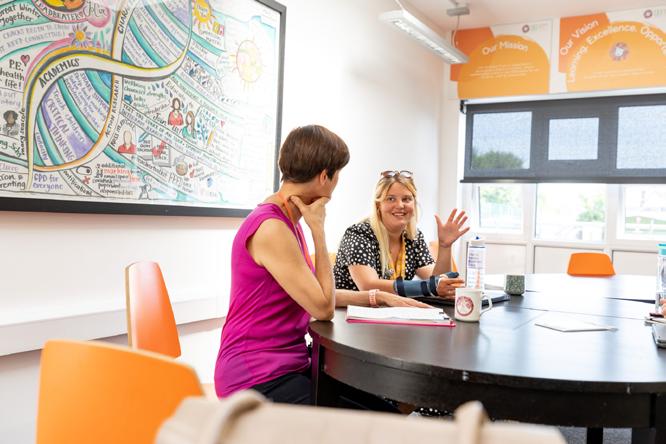
42 Teachers Matter THERESE HOYLE
What Does a Wellbeing-Promoting Culture Look Like?
Have you ever walked into a school and immediately felt a desire to work there? It’s not just about the physical environment - it’s the obvious positive energy, the kindness and the respect that everyone exhibits.
Creating a culture that actively promotes staff wellbeing involves everyone. While the senior management team sets the tone, each individual plays a vital role in shaping the daily atmosphere.

Steps to Build a Healthy School Culture
Step 1: Conduct a Wellbeing Survey Assess the wellbeing of staff through a comprehensive survey. This provides valuable insights into the effectiveness of existing wellbeing initiatives.
Step 2: Create a Culture of Kindness Scientifically proven, kindness improves health and wellbeing. Simple acts like following a kindness calendar or initiating a ‘staff shout out’ board can go a long way.
Step 3: Be a Radiator, not a Drain Are you spreading warmth or negativity? Strive to be a radiator, exuding positivity, warmth and enthusiasm, rather than a drain that depletes energy from those around you!
Step 4: Create a Culture of Ongoing Renewal and Self-Care Prioritise self-care. From a healthy diet to regular exercise, digital detox and mindfulness practices, these habits create a foundation for handling the challenges of school life.
Step 5: Communicate Effective communication is the glue that holds a positive school culture together. Respectful listening, coaching cultures and open forums contribute to
Remember,
a healthy school culture is not just an aspiration - it’s a necessity for the holistic development and success of every member in the school community.
transparency, trust and positive relationships among staff, children and parents.
In conclusion, building a positive school culture is a collective effort. By prioritising staff wellbeing and implementing these steps, schools can create an environment where everyone thrives. For more practical tips and ideas, explore our wellbeing toolkit.
Remember, a healthy school culture is not just an aspiration - it’s a necessity for the holistic development and success of every member in the school community.

Therese Hoyle
Therese is the best-selling author of 101 Playground Games 2nd Edition and 101 Wet Playtime Games and Activities. She runs Positive Playtime and How to be a Lunchtime Superhero programmes in person and online, nationally and internationally.
You may contact her at: www.theresehoyle.com or adminangel@theresehoyle.com
43 THERESE HOYLE
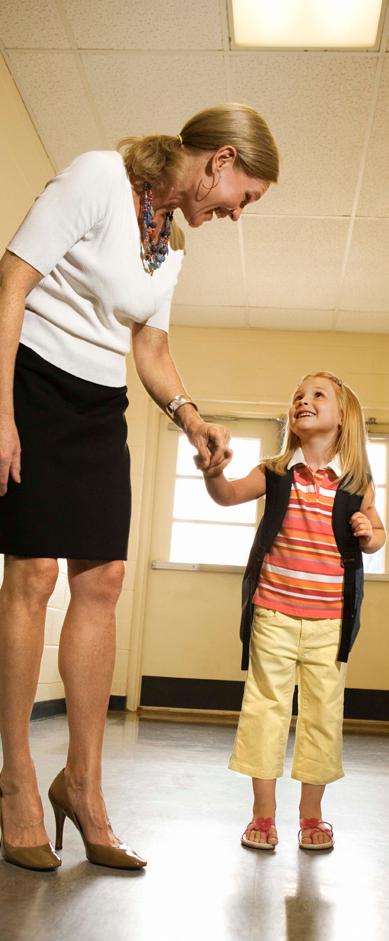
Keeping Kids Safe
Tools for Teachers - A Trusted Adult
Were you aware that with the advent of Artificial Intelligence, children are at risk of sexual abuse, now more than ever? That while children are ‘playing online,’ grooming could be occurring? Would tips on how to protect them be useful?
Sexual abuse and grooming of children across the world are both frightening realities and ways to manage this are desperately needed.
The year my classroom grew to 38 children meant it was impossible for me to speak to them individually every day, let alone notice what was happening in their lives. Consequently, those children who were being groomed and abused were unable to be helped. Although I had suspicions, I didn’t have the tools to deal with them, and that is why I’m grateful to be able to share this information with you.
Don’t underestimate that you are possibly one of, if not the only safe adult for those children you teach. We know that according to global estimates, up to 1 in 3 children will be sexually abused by the time they reach 16 years of age.
Children who are loved at home, come to school to learn.
Children who aren’t come to school to be loved.
– Nicholas Ferroni
44
GLORIA MASTERS
It is a collective effort to Keep Kids Safe - and after all, if not you, then who?
It is not your sole responsibility to keep kids safe but one of the things you can do is to observe what children do. Children do not use words as their main communication choice, that is an adult construct. Children communicate with us through their behaviour. Notice and trust children’s behaviour over their words. That is where the truth lies.
Signs of sexual abuse include but are not limited to:
1. Behavioural changes
2. Increased anxiety or fear
3. Regression in behaviour, such as thumb sucking or baby talk
4. Displaying knowledge of sexual acts and phrases beyond their age
5. Refusing to participate in play they once enjoyed, especially if it means changing clothes for PE, or removing outer items of clothing
6. Signs of self-harm or suicidal thoughts and language
Disclaimer: This does not mean they are being abused, it just signals something is very wrong, and abuse could be occurring.
What To Do:
Outright approaching a child can be counterproductive since they have been conditioned to never tell anyone, and will be unlikely to do so. A less threatening method is to provide the class general information and strategy. Try the following:
1. Introduce a buddy system so that they have someone they can rely on and talk to if they feel unsafe. This is because they may feel safer sharing with a child, and have that support should they eventually approach you.
2. Teach them the hand signal as shown in the diagram below.
3. Brainstorm with the class who they consider a safe adult for them to approach if they were unsafe. It could be a parent, aunty or even you.
GLORIA MASTERS
4. Let them know if you ever see the hand signal used you will support them.
5. Get each pair of buddies to come up with a safe word to use if abuse is occuring or they feel unsafe. The class must vote on which one they would most like to use.
6. Teach them that there are no good secrets. (Why would you want a child to keep a secret?) Replace secrets with the term ‘good surprises,’ so that way there is no room for any confusion!

It is not your responsibility to save every child. But it is your responsibility, as a safe adult, to do your part by taking notice and giving kids tools to help them communicate their need for help and protection. It is a collective effort to Keep Kids Safe - and after all, if not you, then who?

Gloria Masters is an author, speaker and the founder of the Handing the Shame Back Foundation, a charity dedicated to adult survivors of child sexual abuse. She also hosts a YouTube and podcast channel of the same name. In 2022, she released the Global Hand Signal to help protect kids under 16 from abuse and trafficking. Her book, Keeping Kids Safe, is a Roadmap for teachers and parents.
For more information, visit www.gloriamasters.com.
Gloria Masters
45
A Guide for Teachers: Techniques for Dysregulated Students
Implementing Somatic Experiences and Sensory Modulation
As educators, we are encountering students with various emotional and behavioural challenges including rapidly rising numbers of students exhibiting dysregulated behaviours.
A 20023 survey by EAB, an education consulting firm, found that 84 percent of educators reported students are “developmentally behind in self-regulation.” According to an OECD survey, New Zealand students may be some of the worst-behaved in the world, with results revealing the bottom score among developed countries for classroom behaviour for 15-year-olds, and one of the worst of the 81 participating nations and territories.
As dysregulated students struggle to manage their emotions, teachers continue to face disruptions in the classroom environment that hinder learning progress.
These approaches empower students to develop self-regulation skills, improve their emotional resilience and ultimately enhance their academic success.

46 SUE O’CALLAGHAN
energy, enhancing self-awareness and providing students with practical tools to cope with overwhelming emotions.
Examples of somatic experience and sensory modulation techniques that teachers can incorporate to support dysregulated students effectively.
Somatic Experiencing Techniques:
Somatic experiencing involves attending to bodily sensations to regulate the nervous system’s response to stress or trauma. Teachers can integrate the following techniques into their classroom practices:
1. Grounding Exercises:
• Encourage students to focus on sensations like the feeling of their feet on the ground or the rhythm of their breath.
• Guide them through simple grounding exercises, such as gently tapping their thighs or squeezing a stress ball.
2. Body Scans:
• Lead students through a body scan meditation, prompting them to notice and release tension in different parts of their bodies.
• Use visualisations, such as imagining a wave of relaxation flowing through each body part to enhance the experience.
3. Movement Breaks:
• Incorporate brief movement breaks into the daily schedule, allowing students to engage in activities like stretching, yoga poses, shaking exercises or mindful walking.
• Emphasise the connection between movement and emotional regulation, encouraging students to notice how physical activity (such as drama, dance and sport) impacts their mood.
Sensory Modulation Techniques:
Sensory modulation focuses on managing sensory input to regulate arousal levels and emotional responses. Teachers can create a sensory-friendly environment and implement the following strategies:
1. Calming Sensory Tools:
• Provide access to sensory tools such as fidget toys, weighted blankets or noise-cancelling headphones.
• Allow students to choose the tools that work best for them and encourage their use during times of distress or overstimulation.
2. Sensory Break Areas:
• Designate a quiet, cosy corner of the classroom as a sensory break area where students can retreat when feeling overwhelmed. (In Secondary/High School, a ‘Safety Exit Plan’ contract with Deans or Heads of Year allow students to leave to a designated Safe Person such as a school counsellor.)
• Stock the area with calming resources like soft pillows, soothing music or sensory bottles filled with glitter and water.
3. Visual Supports:
• Use visual schedules, timers or cue cards to help students anticipate transitions and manage their time effectively.
• Incorporate visual aids that depict calming strategies, such as deep breathing exercises or progressive muscle relaxation techniques.
• Use creativity as a form of expression where trapped emotions can be expressed externally, shifting from an internal felt response.
By integrating somatic experiencing and sensory modulation techniques into teaching practices, teachers can create a more trauma-informed, effective and supportive learning environment that caters to the needs of dysregulated students. These approaches empower students to develop self-regulation skills, improve their emotional resilience and ultimately enhance their academic success. As educators, let’s prioritise the holistic well-being of all our students by incorporating some of these effective strategies into our classrooms.
 Sue O’Callaghan
Sue O’Callaghan
Sue is a published author, public speaker, mother and passionate advocate for mental health. Founding Teenage Toolbox in 2013, she works as a trauma therapist, specialising in self-harming behaviour, addiction, anxiety, depression and suicide. In addition to delivering traumainformed programmes to schools, she runs teacher training events, parent workshops and resilience events. She also offers couples’ counselling, adult therapy and teacher supervision.
Sue can be contacted via her website: www.teenagetoolbox.com.
47
SUE O’CALLAGHAN
Understanding and Feeling Excited About Compounding
3 Simple Ways to Guiding Children Explore Money Choices
Compounding is the mathematical formula that makes our money work for us. Over TIME, it magically multiplies and grows saved and invested money without us having to physically work for it. Simply put, it’s when one earns money on the initial amount saved or invested PLUS on the money earned (interest on savings and returns on investments). So each year, the amount one earns increases.
Through compounding, MONEY MAKES MONEY. Then, THAT MONEY MAKES MORE MONEY…and on and on the cycle of building wealth goes!
The goal is to teach children how to earn rather than pay for it! It can help them build wealth for themselves over time, or it can help them get into the cycle of living paycheck to paycheck and amassing large amounts of toxic, personal debt.
In the words of Warren Buffett, one of the greatest investors of all time, “My wealth has come from a combination of living in America, some lucky genes and compound interest…”
Here are some ideas to help normalise compounding:
understand how the formula works, they just have to know that it does.
• Google, “What did Albert Einstein say about compound interest?” The answer will be something along the lines of “...it’s the eighth wonder of the world. He who understands it earns it; he who doesn’t, pays it.”
• Ask them if they would like to earn money without having to work for it. When they answer yes, tell them there is a way and you will show them how. Explain that if they invest some of their money, rather than just spending it all, their invested money can multiply and grow for them through compounding. You can also show them how it makes their saved money grow, but often this can be disappointing because usually interest rates are fairly low.
Compounding and passive income are the ways to true financial freedom and both require time, so start as soon as possible.
1. Talk about it. Introduce the concept gradually and talk about it regularly.
• Explain it as a mathematical formula that magically makes money multiply and grow from small amounts to big amounts OVER TIME. They don’t have to
• Help them imagine compounding as a small snowball getting bigger and bigger as it rolls down a hill and gathers more and more snow. The small snowball is the money they decided to save and invest rather than spend.
• Explain they can choose for it to be their friend or their foe. It can make their money grow for them or it can take money away from them, for example credit cards. This could lead seamlessly into a conversation about credit card management.
2. Use Compound Interest Calculators
older children, invite them to use online
Teachers Matter
48 LAUREL MAKOWEM
For
calculators

so they can actually see the magic happening right in front of their eyes. There are literally hundreds to choose from and two of my favourites are Money Hub and Live Sorted. Google either or both together with “compound interest calculator.”
You will be asked to input some information:
- Original amount saved or invested (can be anything, including $0)
- Your ongoing weekly, monthly or annual contributions
- Rate of interest or return (I suggest you try different rates, ranging from 5% - 12%). For fun, see what happens when you use 100% as the rate.
- How many times the money compounds during the year.
3. Invite the
Compound Interest Fairy to Visit
For younger children, set up six transparent money jars and label them GENIUS, GOALS, GET, GROW, GUARD and GIVE. Each time the child ‘earns’ money, put half of it (The Investing Habit) into their GROW jar. Explain that if they leave their money in the GROW jar, just like the tooth fairy visits when they lose a tooth, so will the COMPOUND INTEREST FAIRY visit and add more money to their jar, IF THEY LEAVE THEIR MONEY IN THEIR GROW JAR. If they decide to take it out and spend it, they won’t get a visit and their money won’t multiply and grow.
You could use lego pieces, buttons or little stones to demonstrate the idea of magically growing - if they can leave it alone, of course!
When children grasp the concept of their money growing for them (over time) without them having to actually work for it, there can be a willingness to spend less and save more, which is a life skill most adults have not had the opportunity to learn and practice.
Compounding and passive income are the ways to true financial freedom and both require time, so start as soon as possible.

Laurel Makowem is a Certified Financial Education Instructor and founder of Mothers Teaching Money, a business and movement helping parents raise financially confident, responsible and independent adults, regardless of their own financial knowledge or situation.
Her mission is to demystify financial literacy through the Millionaire Mindset Money System, a comprehensive holistic financial education system. She provides fun online courses, workshops and products for children from 4-18 years.
Contact her at mothersteachingmoney@gmail.com
Laurel Makowem
49 LAUREL MAKOWEM
JUDITH YEABSLEY
What Chicken Nuggets Taught Me
Introducing New Foods Without Pressure or Panic

Working with over 100 families a year provides a lot of stories from the meal table. Some of them are memorable because they teach me a valuable lesson that I can then share with others. One of these stories is the lesson of the chicken nuggets.
Chicken Nuggets – And the ‘Must Haves’
Often, challenged eaters have a fairly narrow range of foods they eat. Because of this, they tend to have them every day, or at least on a very frequent basis. This leads to multiple challenges:
1. Repetition Narrows Choices - The more often a child eats only a narrow band of foods, the more difficult it becomes to accept foods outside of those choices.
2. Boredom - If a child eats the same foods over and over again, it is quite common to get bored eating them.
3. Dropping Foods - It is common for challenged eaters to drop foods. If you ate a particular food day in and day out, wouldn’t you get bored? I would. Or maybe a child has a ‘bad’ experience and no longer wants to eat that food. It may be something minor in the scheme of things but it can put a food hesitant child off eating. For example, a bad experience could be when a sandwich goes mushy in a lunch box.
4. Rigidity Increases - When children are eating a narrow range of foods they can become hyper-focused on them, which may cause them to notice minute imperfections or begin to refuse foods unless they are exactly the same. In fact, this is a really common, but rarely discussed issue. It may be only accepting a particular brand, but it can also extend to having only the ones that are cooked an exact way or by a specific parent. It makes things far more challenging for the whole family on a lot of levels:
i.) Expecting Perfection - Not only does the child want certain foods that can be served but will also expect to have a parent buy, prepare, cook or serve it in a specific way.
ii.) Socially Challenging - A child is less socially flexible since they may be served a favourite food
50
Parents do make a difference. No matter how extreme or stubborn a child seems around food, parents can support them to add new foods.
at friend’s or school, but be unable to eat it if it’s a slightly different brand or version.
iii.) Family Restricted - The family may be limited in how they can operate in terms of travel, restaurants and socialising. One of the mums I spoke to was in this exact, difficult situation. Her son ate a limited number of foods and was becoming more and more rigid about the specifics of the foods he did eat. One of these was chicken nuggets.
The Story of the Chicken Nuggets
Mum was being driven crackers by the chicken nuggets. Her son would only accept one brand of nuggets and she was frustrated as this caused them not to go to a café or a restaurant where a different nugget was served. When they tried it, it was like new food for her child.
Like most parents, she found it really difficult to accept that there was a noticeable difference between brandsespecially to the point where only one was deemed okay and all the rest were rejected. She got nowhere discussing this with her son - he refused to even contemplate eating a different nugget. Mum was on a mission and decided that she was going to crack this, she was going to introduce a new chicken nugget, however long it took.
There are gentle ways to do this, and this is the course she took. From then on, every time she served chicken nuggets, she would serve a portion of the favoured brand and next to them, one piece of a new brand of nugget. She did this week in and week out. One evening after about two months, her son suddenly picked up the new nugget, bit into it and said, “Hey! These are okay.” There were many emotions running through mum at that moment, as you can imagine!
JUDITH YEABSLEY
The Lessons of the Chicken Nuggets
1. Challenge - If a child has a limited diet, adding new foods is not going to be easy. It will probably also be a slow process.
2. Rigidity - The more rigid around food a child becomes the more challenging things are.
3. Superheroes - Parents do make a difference. No matter how extreme or stubborn a child seems around food, parents can support them to add new foods. This mum was one I had worked with before this, so while she had extra tools, she also thought this through and came up with her own plan.
I love this story, not because it’s an unusual story, (In fact, I have seen the same sort of thing happen over and over.) but more because it’s such a simple way to see how things can work and how parents can support a child to take steps forward. None of this was about forcing her child to eat a brand new food item. It was all about exposing him to it, allowing him to become comfortable with it and most importantly, giving him the opportunity to eat it in his own timing. If she hadn’t served it he wouldn’t have been able to eat it. When she served the new chicken nuggets she also did not make a big song and dance and attempt to convince him to eat them.
Primarily, she just served them with no pressure on him to perform. Over the course of the two months, she didn’t hear him say anything about the new chicken nuggets. She did not see him touch them. In fact, there were zero external signs he was even noticing that new chicken nugget that was always there. But the process worked. And that is the lesson of the chicken nuggets.

Judith Yeabsley
Judith is an AOTA accrediated picky eating advisor and internationally nutriontional therapist. She works with hundreds of families every year resolving fussy eating and returning pleasure and joy to the meal table. She is also mummy to two boys and the author of Creating Confident Eaters and Winner, Winner I Eat Dinner. Her dream is that every child is able to approach food from a place of safety and joy, not fear.
You may contact her at: Judith@theconfidenteater.com
51
LESLEY JOHNSON
Dancing Hands – Hand Talk
Celebrating Diversity by Preparing for International Week of Deaf People
The theme for this year’s celebrations for the International Week of Deaf People is, “Building Inclusive Communities for All.” An amazing starting point for teachers who would like to prepare for September 20th-26th could be to explore the themes within the beautifully written picture book BOY, by Phil Cummings.
The king’s battles with the dragon were frequent, mighty and loud. Cling! Clang! Clong! Roar!
Boy lived in silence and couldn’t hear the fighting but Boy could see the fear on the faces of people around him and he could understand how everyone would be much happier without it. From CBCA Honour Award-winning team, Phil Cummings and Shane Devries, comes this tender tale of power and perception.
Use of Graphic Organisers:
• Retell the story using the consequences wheel. You may need to add more sections.
• Compare using a fishbone Cause and Effect organiser. It will help you analyse what was happening in the story and why events transpired as they did.
• Choose one character (King, BOY or Dragon). Circle the habits you think they either display or may need. Be prepared to share the reasoning behind your selection.
What do we know of and expect from Deaf and Hard of Hearing (DHH) children in regard to their reading and phonological progress?
In The Journal of Deaf Studies and Deaf Education, Volume 25, Issue 3 the study undertaken found:
“The DHH children surveyed made progress in vocabulary learning and were acquiring the syntax of either English (spoken-only and bimodal children) or ASL (sign-only and bimodal children). Thus, despite delays, children were acquiring language to which they had access in their environment. They were also developing phonological processing skills either auditorily or visually. However, for all groups, delays in reading comprehension increased in higher grades.
The hope is that future research might clarify how and why classroom instruction influences these outcomes. The challenge, as always, will be to develop evidence-based instructional strategies that will lead to improvement in literacy for all children while taking advantage of their opportunities for visual and auditory access to language.”
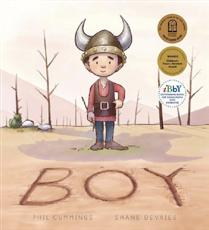
Title: BOY
Author: Phil Cummings
Illustrator: Shane DeVries
Publisher: Scholastic Press
ISBN: 978-1-76112-489-1
Teachers Matter
52
Offer readalouds and shared reading with additional visuals or sign language supports.
LESLEY JOHNSON

So how can we, as teachers, assist DHH children to achieve their best specifically in the area of reading?
Reading Rockets has some suggestions:
• Use visual aids and multimodal supports for teaching phonics and decoding.
• Offer read-alouds and shared reading with additional visuals or sign language supports.
• Make read-alouds more engaging by adding gestures, facial expressions and voice changes to convey the meaning and emotions.
• During read-alouds, encourage students to respond to you and peers at routine stopping points — for example, make a prediction or answer a question.
• During read-alouds, ask children to join in by pointing, signing or chiming in (if a child is verbal) at a specific word or phrase.
• Provide frequent and explicit feedback during reading to spot-check understanding.
• Use graphic organisers and anchor charts to focus attention on specific skills or strategies.
• Encourage children to engage in wide reading for pleasure, and to interact with peers and adults through reading activities. You can use online tools or consult with a librarian to find books that match their interests and abilities. Include books that relate to or share experiences of DHH children.
• Provide a diverse range of texts and genres to expand children’s vocabulary and background knowledge. Books with clear illustrations, simple sentences and repetitive words may help to introduce new topics and vocabulary.
• Include books for the classroom that feature sign language or captions to make them more accessible.
And as with ALL children, provide teaching that encourages and values self worth. As BOY has taught us: Difference only brings a new perspective that is for the good of everyone.
53
LESLEY JOHNSON
Books that can be added to your library:
Deaf Child Crossing by Marlee Matlin
Wonderstruck by Brian Selznick
El Deafo by Cece Bell
Hello, Universe by Erin Entrada Kelly
Feathers by Jacqueline Woodson
Dad, Jackie, and Me by Myron Uhlberg
The Deaf Musicians by Pete Seeger, Paul DuBois Jacobs
Time to Sign: Sign Language for Kids by Kathryn Clay
My Language, Your Language by Lisa Bullard
Listen: How Evelyn Glennie, a Deaf Girl, Changed Percussion by Shannon Stocker
Kami and the Yaks by Andrea Stenn Stryer
Moses Sees a Play by Isaac Millman
Gracie’s Ears by Debbie Blackington
Dad and Me in the Morning by Patricia Lakin
Ranvir Cannot Hear by Genevieve Yusuf
Freddie and the Fairy by Julia Donaldson
BOY by Phil Cummings


Age Level: 9-12
Age Level: 9-12
Age Level: 9-12
Age Level: 9-12
Age Level: 9-12
Age Level: 6-9
Age Level: 6-9
Age Level: 6-9
Age Level: 6-9
Age Level: 6-9
Age Level: 6-9
Age Level: 6-9
Age Level: 6-9
Age Level: 3-6
Age Level: 3-6
Age Level: 3-6
Age Level: 3-6
Genre: Fiction
Genre: Fiction
Genre: Fiction
Genre: Fiction
Genre: Fiction
Genre: Fiction
Genre: Fiction
Genre: Nonfiction
Genre: Fiction
Genre: Biography
Genre: Fiction
Genre: Fiction
Genre: Fiction
Genre: Fiction
Genre: Fiction
Genre: Fairytales, Folk Tales, and Tall Tales
Genre: Fiction

Lesley Johnson has taught for 30 years. The facilitation of an ICTPD cluster nurtured her three passions: Literacy, ICT tools and Thinking Strategies. She now runs her online business, Read Think Learn, providing online literacy resources that promote higher order thinking.
For more information, please visit: www.readthinklearn.com
Teachers Matter
Lesley Johnson
54

Embracing Silence
A Pathway to Self-Care and Inner Wellness
“Silence is a source of great strength.” – Lao Tzu
My mind is a very busy place. I recently went on a four day silent retreat. I know! I make my living speaking and survived four days without talking! My family and friends told me I would die! (Spoiler alert - I didn’t!)
I playfully said I was going over the Easter break to avoid chocolate and my kryptonite, hot cross buns. As a recovering (might depend on who you ask!) control freak, I was secretly concerned and a little anxious about no contact with the outside world. No phone, no Internet, no books – just me alone with a million thoughts and open tabs in my mind.
There were twenty-one of us on the retreat. We had our first evening talking and introducing ourselves and then we were silent for a full three days, participating in seven meditation sessions, yoga and philosophy teachings daily. I didn’t even know how to meditate. I learned how to sit, to quiet my mind and to be still.
I loved it!! The quiet and stillness were incredible. To truly slow down, hear my thoughts, acknowledge and witness them and, more importantly, listen to and feel my heart was profound. It got me thinking about how little quiet and stillness there is in most of our daily lives.
Each morning, before breakfast, I went for a walk along the road to enjoy the fresh morning air and the sun rising. This was a rural community with dairy farms dotted around the region. It was this road sign that also had me pondering. “Slow down – Don’t burst their bubble.” Horses need extra space on the road and I loved the bubble idea. In what ways might you create moments of ‘bubble time’ to protect yourselves from the fast, busy and noisy world that might derail you?
The great news? You don’t need to go on a retreat to do this! Creating stillness in your life is essential. I’m going to suggest it is one of the MOST IMPORTANT selfcare and wellbeing gifts you can give yourself.
This might seem overwhelming. It might even feel scary to be alone with your thoughts. Often, noise is
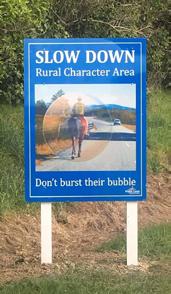
55
KAREN TUI BOYES
KAREN TUI BOYES
a distraction from feeling, thinking or dealing with what is really going on.
In Marianne Williamson’s writings, made famous by Nelson Mandela, she wrote:
“Our deepest fear is not that we are inadequate. Our deepest fear is that we are powerful beyond measure. It is our light, not our darkness that most frightens us. We ask ourselves, ‘Who am I to be brilliant, gorgeous, talented, fabulous?’ Actually, who are you not to be? You are a child of God. Your playing small does not serve the world. There is nothing enlightened about shrinking so that other people won’t feel insecure around you. We are all meant to shine, as children do. We were born to make manifest the glory of God that is within us. It’s not just in some of us; it’s in everyone. And as we let our own light shine, we unconsciously give other people permission to do the same. As we are liberated from our own fear, our presence automatically liberates others.”
Getting Started:
4. Nature Pit Stop: On your way home from work, pause at a nearby nature spot. Take a moment to inhale the fresh air and let the tranquility of the outdoors replenish you.
5. Mindful Media Consumption: Be mindful of the news you consume. Steer clear of stories that weigh heavy on your heart, especially those beyond your control. Sometimes, a break from the news cycle can bring much-needed peace.
6. Early Morning Bliss: Wake at 5 am and indulge in some quiet time for yourself. Experience the stillness that envelops the world at this magical hour.
The journey toward embracing silence and stillness is a gradual process. Just as with any skill or habit, it requires patience, consistency and dedication.
The journey toward embracing silence and stillness is a gradual process. Just as with any skill or habit, it requires patience, consistency and dedication. Choose one idea at a time and integrate it into your daily routine. Embrace both the productive and stagnant sessions, recognising that each moment offers an opportunity for growth and self-discovery.
Here are some suggestions to create more quiet and stillness in your world…
1. Stroll in Silence: Leave the distractions of audiobooks, podcasts and music behind as you embark on a quiet walk. Take in the splendour of your surroundings and let nature be your soundtrack.
2. Journaling Journey: Dedicate 5-10 minutes each day to journaling. Begin by expressing gratitude for the blessings in your life and reflect on how you aspire to impact the world around you positively.
3. Drive in Peace: Turn off the radio or your music while you drive. Embrace the serenity of silence.
7. Tech-Free Mornings: Resist the urge to reach for your phone or scroll through social media first thing in the morning. Instead, savour the moments after your morning routine, allowing yourself to ease into the day with calmness.
8. Soothing Soak: Treat yourself to a leisurely bath. Light a candle, sink into the warm water, and luxuriate in the blissful silence that surrounds you.
MORE Busy Mind
Hacks to help you navigate the chaos of daily life:
• Task Taming: Begin your day with a brain dump to unload and organise your tasks. Prioritise them to create a clear action plan, allowing your mind to focus on execution rather than juggling to-do lists.
• Distraction Detox: Minimise distractions by closing social media and muting notifications. When drafting documents, disable spell check to immerse yourself fully in the creative process. Remember to re-enable spell check later for accuracy.
• Tidy Transition: Before leaving work, take two minutes to organise your workspace. This small act ensures a tidy environment for a seamless start the next day.
• Prep for Tomorrow: Before going to sleep for the night, jot down a list of tasks for the following day. This preemptive planning can alleviate mental clutter and help you sleep better.
Teachers Matter
56

• Focused Flow: Resist the urge to multitask. Instead, tackle one task at a time with concentration, fostering a sense of accomplishment and efficiency.
• Mindful Interludes: Incorporate mindful breaks into your day. Step away from your desk or classroom for a change of scenery, indulge in a brief dance, or enjoy a humorous video. Engage in activities that uplift your spirits and rejuvenate your mind.
• Grounding Rituals: Create grounding rituals to anchor yourself amidst the chaos. Whether it’s walking barefoot on grass, stretching your body or a meditative moment, these practices promote mental clarity and inner peace.
• Nutrition for Neurology: Nourish your brain with hydrating fluids and brain-boosting foods to combat mental fog. A well fuelled brain operates with heightened focus and clarity.
• Mindfulness Tools: Use mindfulness activities and apps to cultivate a calm and a centred mindset. Explore resources like the mindfulness practices outlined in my previous article for effective techniques to ease mental turbulence. https://karentuiboyes. com/2020/06/mindful-activities-and-practices/
Epilogue (I’ve always wanted
to write one!)
As I reflect on the past week since the retreat, it feels as though I’ve undergone a profound reset—a return to my ‘factory’ setting of centeredness, calmness, focus, energy and purpose. Life seems to unfold at a gentler pace now. I’ve made conscious changes to stop playing the game on my phone and reduce my aimless scrolling on social media, seeing how much this has been a distraction in my life.
I have continued to be still for 40 minutes each morning and practice the techniques I have learned. These include:
- Focusing my attention on my breath, counting each inhalation and exhalation in series: 1-7, 1-14, 1-21, 1-28, and so forth.
- Cultivating awareness of the pause between each incoming and outgoing breath.
- Using box breathing, a technique involving inhalation for a count of 4, holding for 4, exhaling for 4 and holding for another 4.
- Silently saying the mantra ‘so hum’ or ‘I am’ with each breath cycle, aligning ‘so’ or ‘I’ with the inhale and ‘hum’ or ‘am’ with the exhale.
After this transformative experience, I am even more convinced that stillness is the key to wellbeing. I am a work in progress and intend to maintain my daily practice for no other reason than that I feel so alive and vital. I sense that I am uncovering more of my true essence—my authentic self. It is totally worth the effort. Watch this space!
 Karen Tui Boyes
Karen Tui Boyes
Karen Tui Boyes is a champion for LifeLong Learning and is on a mission to transform education globally. Described as an educational alchemist, a conscious creator and a playful priestess, she grounds the research into practical strategies which positively impact teaching and learning.
A multi-award-winning speaker, educator and businesswoman, she is the CEO of Spectrum Education, Principal of Spectrum Online Academy and the author of 12 books.
Find out more at: www.spectrumeducation.com
57
KAREN TUI BOYES













 Helen Verroux
Helen Verroux


 Sally Foley-Lewis
Sally Foley-Lewis






 Erika Twani
Erika Twani











































 Sue O’Callaghan
Sue O’Callaghan












